Best MicroSD Express Cards for Nintendo Switch 2 in 2025 — the best cards on the market, benchmarked and ranked
We've compiled a list of the best microSD Express cards for the Nintendo Switch 2 with options from 128GB to 1TB.
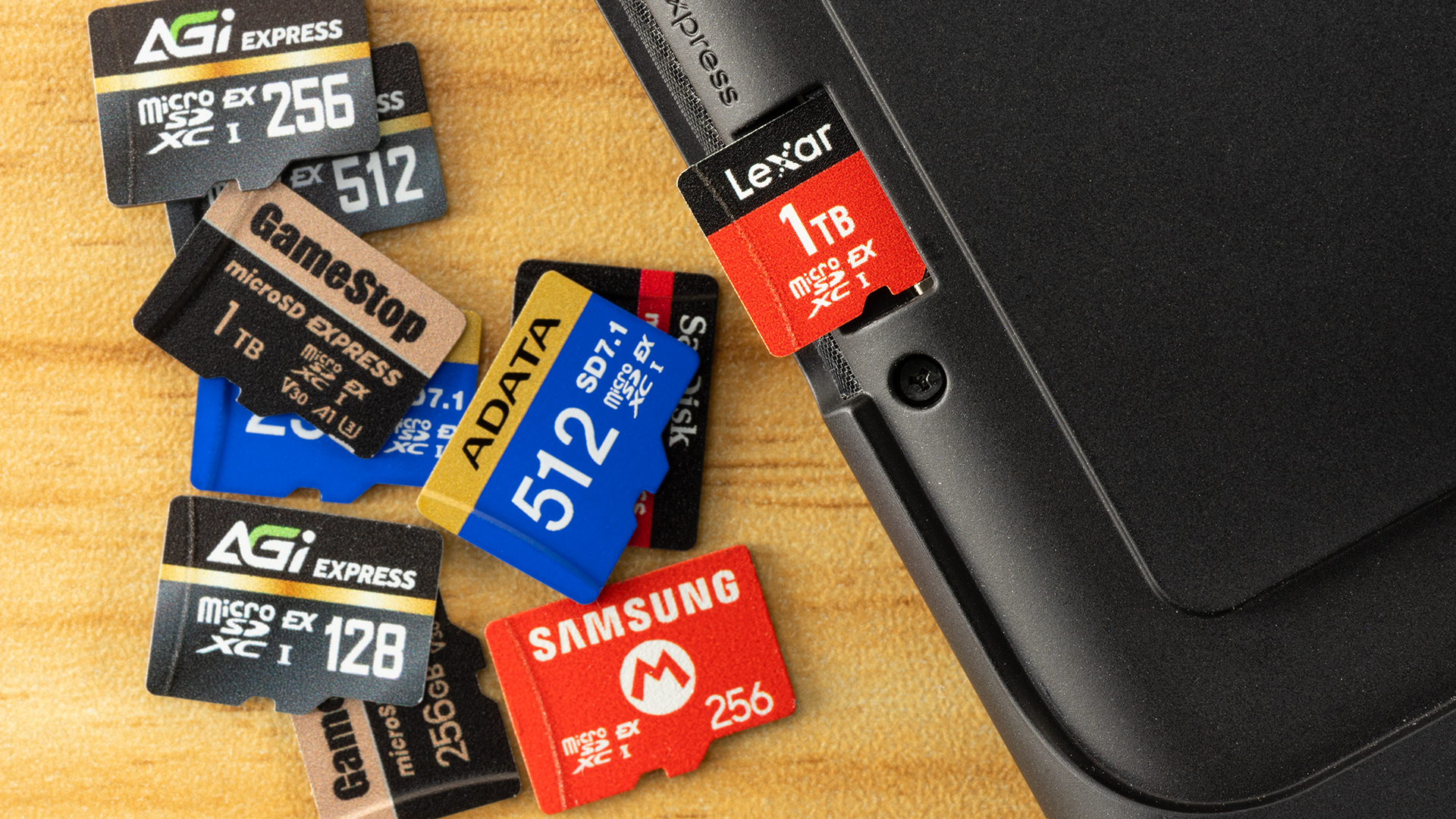
If you're looking for the best microSD Express cards for the Switch 2, our picks below, curated from our in-depth benchmarking, will show you the top cards available on the market right now. The Nintendo Switch 2 is one of the most highly anticipated launches in the world of gaming handhelds. It has met expectations by introducing a series of solid hardware upgrades, notably including significantly faster internal storage, complemented by microSD Express cards for expandable storage.
The original Switch featured 32GB of eMMC storage, a figure that subsequently doubled in the OLED version. The Switch 2, on the other hand, arrives with a whopping 256GB of UFS 3.1 storage, a massive upgrade in both capacity and speed. The Switch 2 offers gamers up to 7X more storage capacity compared to the Switch and up to 3X more than the Switch OLED.
As is customary with gaming consoles, not all of the internal storage is available to you. For the Switch 2, Nintendo has allocated approximately 7GB of the 256GB for system use. Consequently, the actual usable space amounts to approximately 249GB. However, while 249GB of storage capacity may appear like a lot on paper, any avid gamer would dispute this perception.
Take first-party titles such as Mario Kart World and Donkey Kong Bananza, for example — two games that will likely make your Switch 2 collection. They require approximately 22GB and 9GB of storage space, respectively. Modern AAA games aren't any lighter, either. If you like genres like Cyberpunk 2077 and Split Fiction, those occupy an additional 60GB and 70GB, respectively. Thus, only four games have already eaten up half of your available storage. If you share your Switch 2 with your children or a family member, space becomes even more important. The internal storage will inevitably fill up as your gaming library grows.
In its initiative to modernize the Switch 2, Nintendo adopted the microSD Express standard, thereby becoming a pioneer in this area. As of the time of this publication, the Switch 2 is the only device to use microSD Express cards. Although the standard has been in place since 2019, it has not yet gained momentum, which has primarily led to the limited availability and high cost of microSD Express cards.
Best MicroSD Express Cards At A Glance
Why you can trust Tom's Hardware
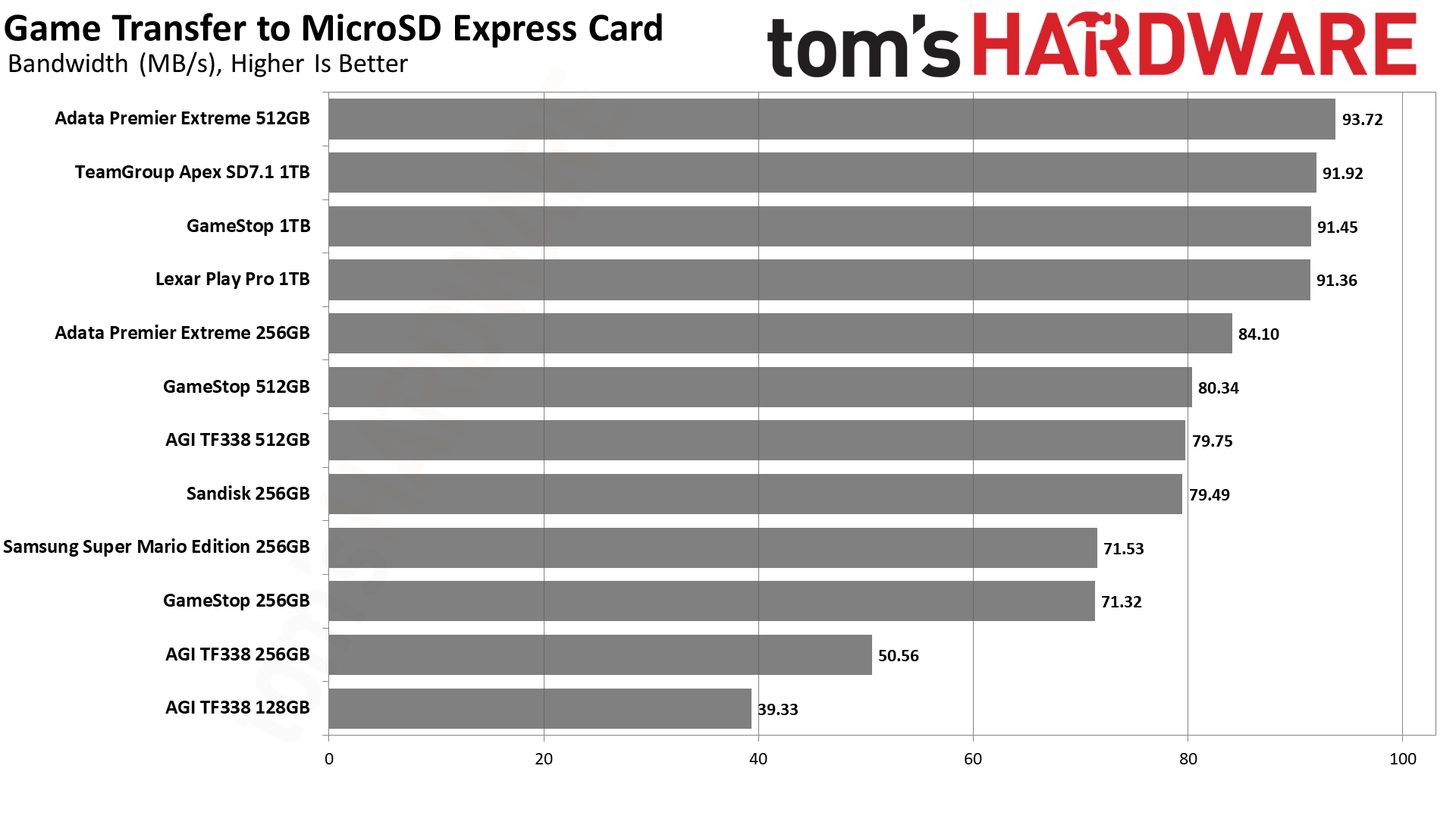
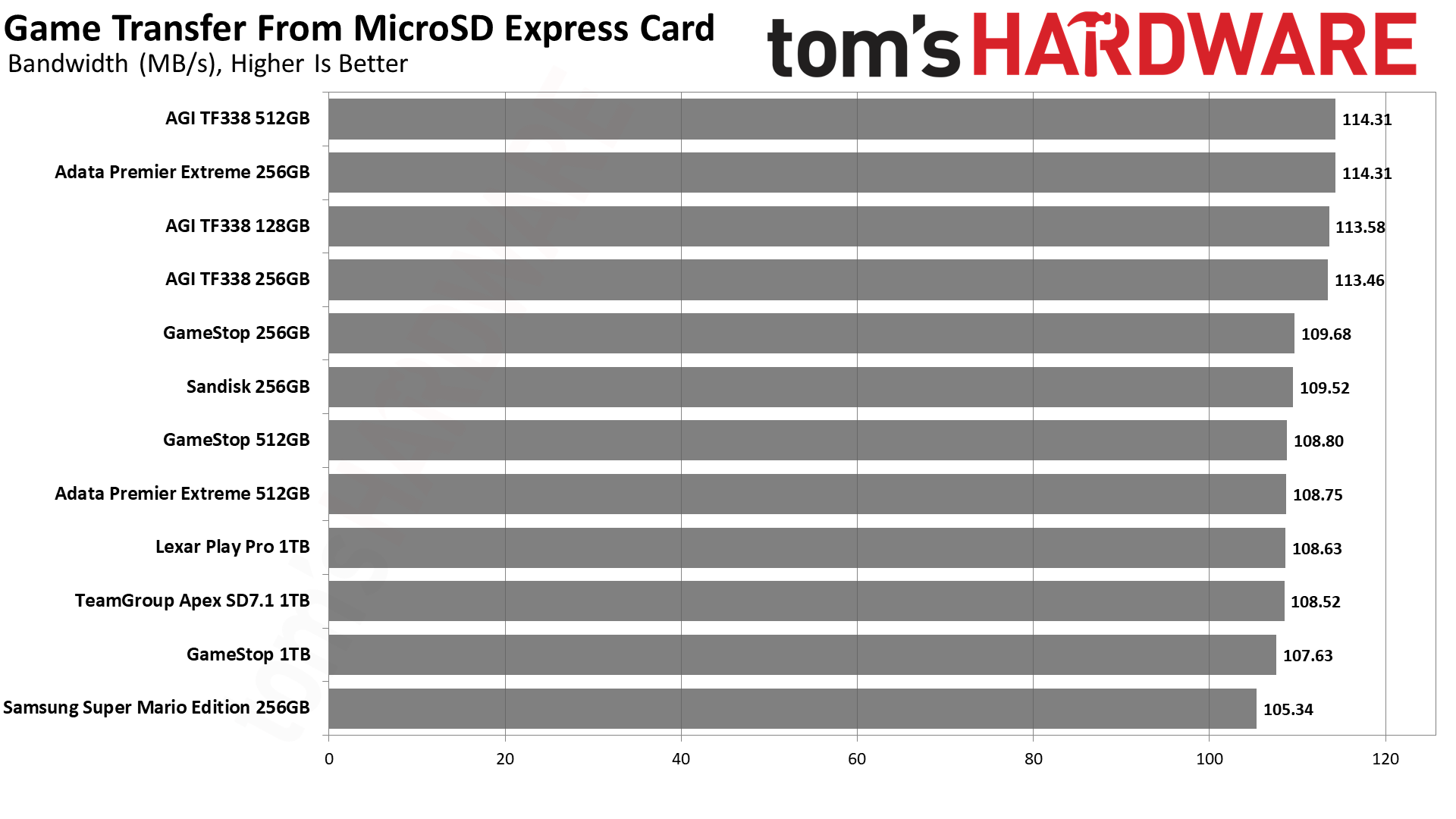
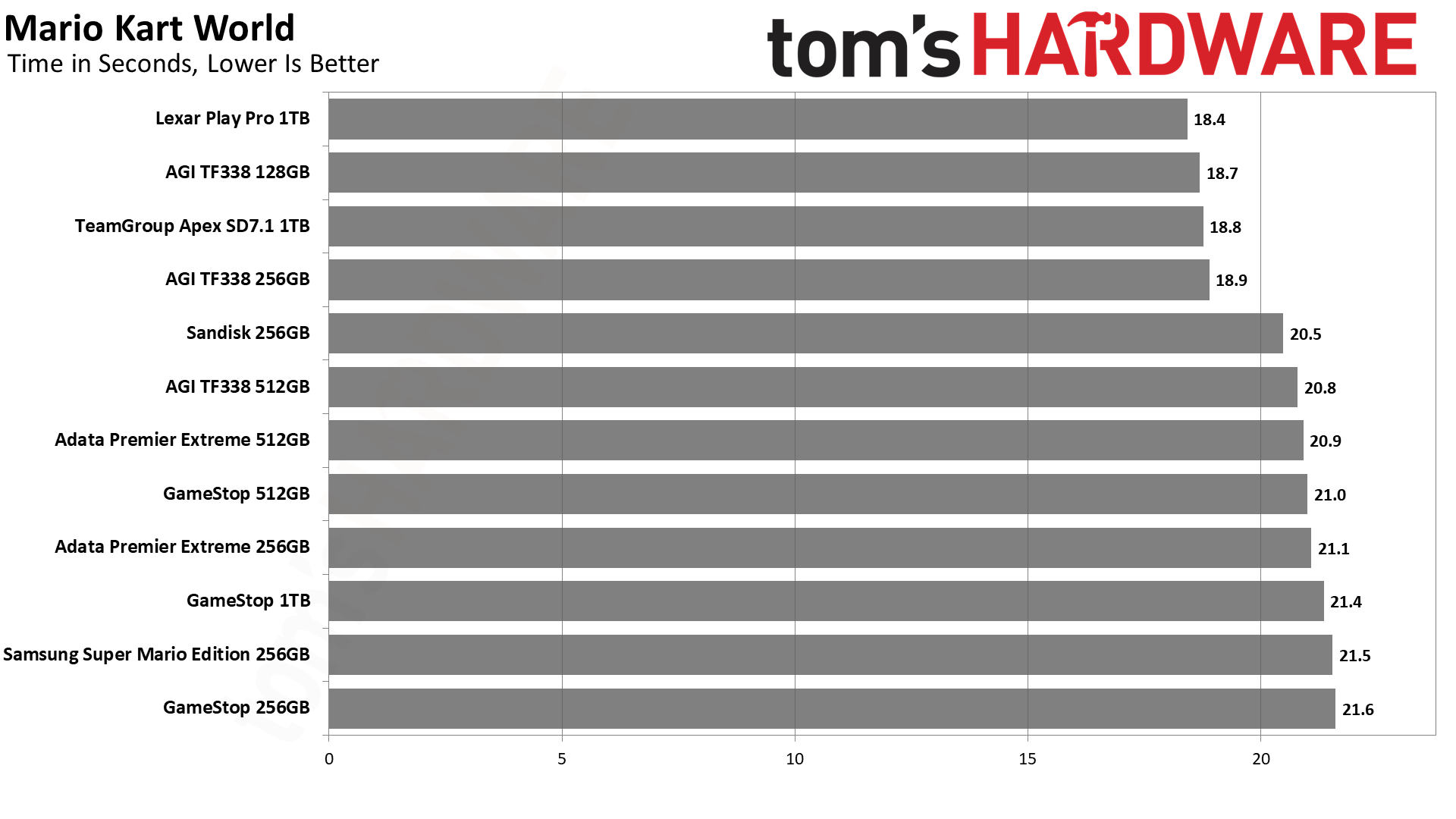
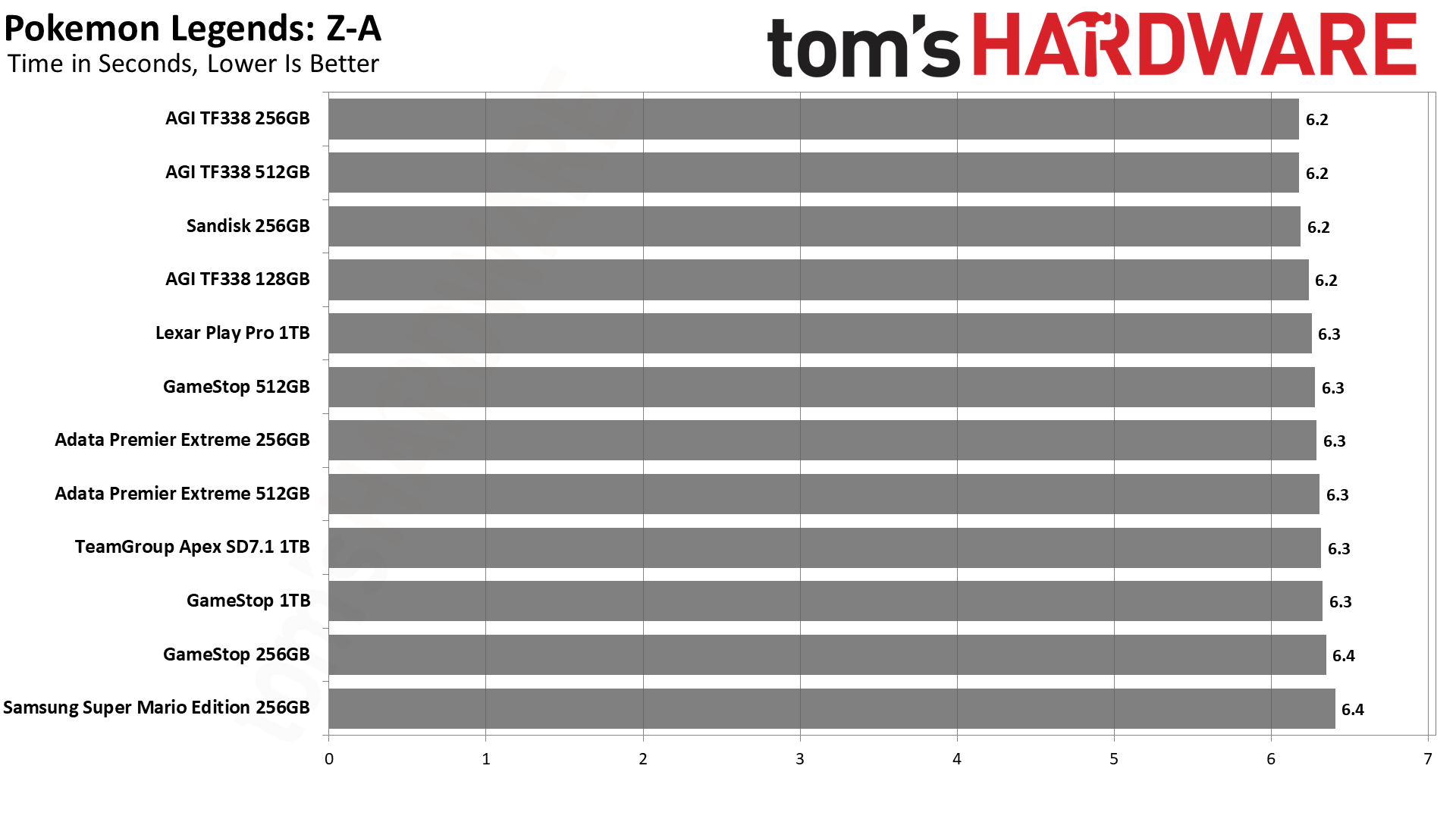
Here's the shortlist of our recommendations and rankings, but we have a more detailed card-by-card breakdown and far more detailed in-depth performance benchmarks of these drives below. To find the best microSD Express cards for the Switch 2, we tested numerous cards of different capacities from various vendors.
Capacity | Best microSD Express Card | Alternative |
|---|---|---|
Best 1TB Card | ||
Best 1TB Budget Card | Row 1 - Cell 2 | |
Best 512GB Card | ||
Best 256GB Card | ||
Best 128GB Card | Row 4 - Cell 2 |
Further below, we also have a hierarchy that ranks the microSD Express cards based on performance. Since it’s not possible to evaluate every card due to regional availability, we will continue testing and updating our recommendations as new cards become readily available for purchase in the U.S. market. We also have a detailed definition and explanation of the different speed classes across the various generations of the microSD specification.
Best 1TB MicroSD Express Card
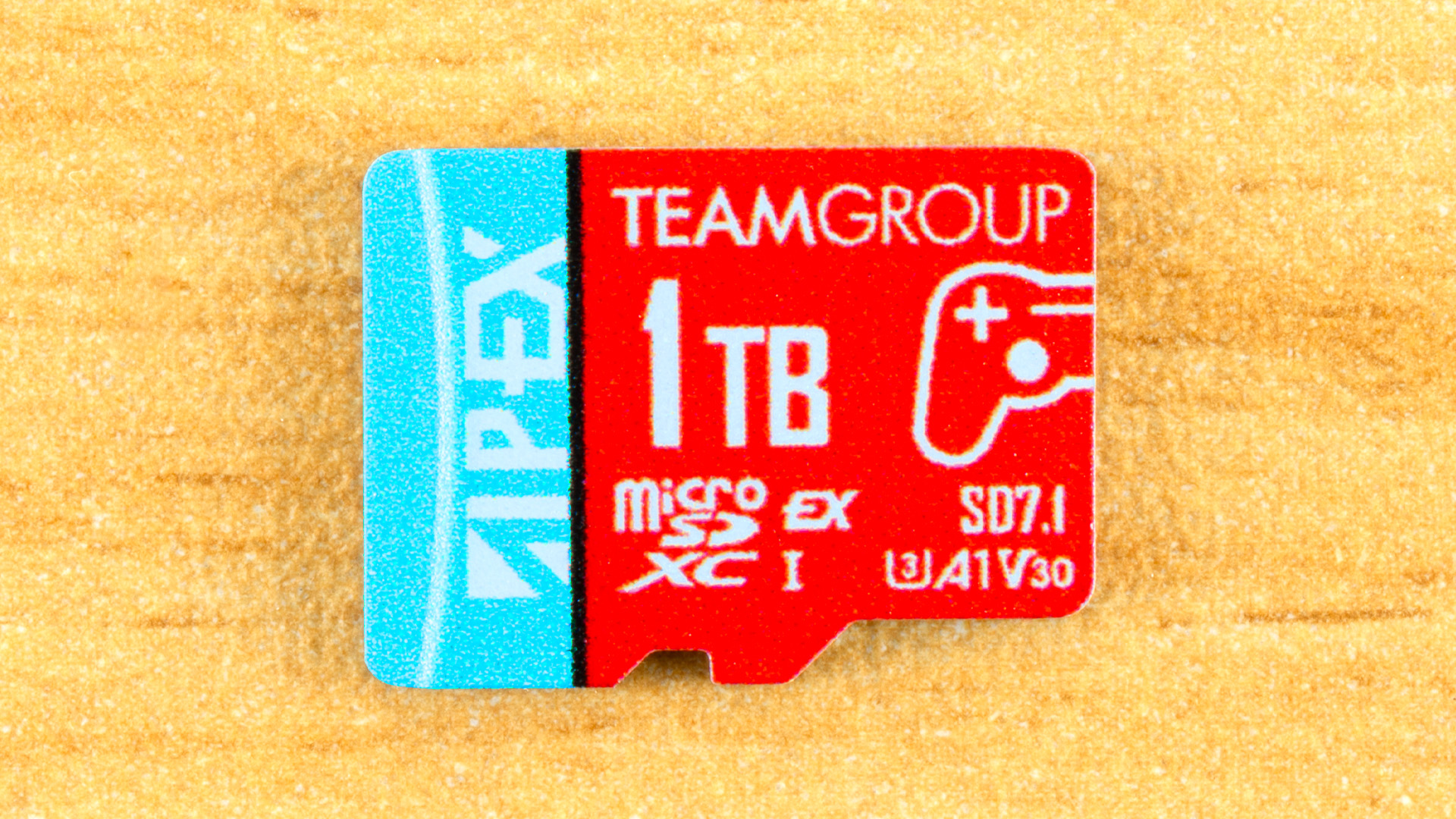
1. TeamGroup Apex SD7.1 1TB
Our expert review:
Specifications
Reasons to buy
Reasons to avoid
The TeamGroup Apex SD7.1 1TB stands out as the fastest 1TB microSD Express card we've tested so far. Priced at $209.99, it's a more budget-friendly option than the Lexar Play Pro 1TB and also comes with the reassuring benefit of a limited lifetime warranty.
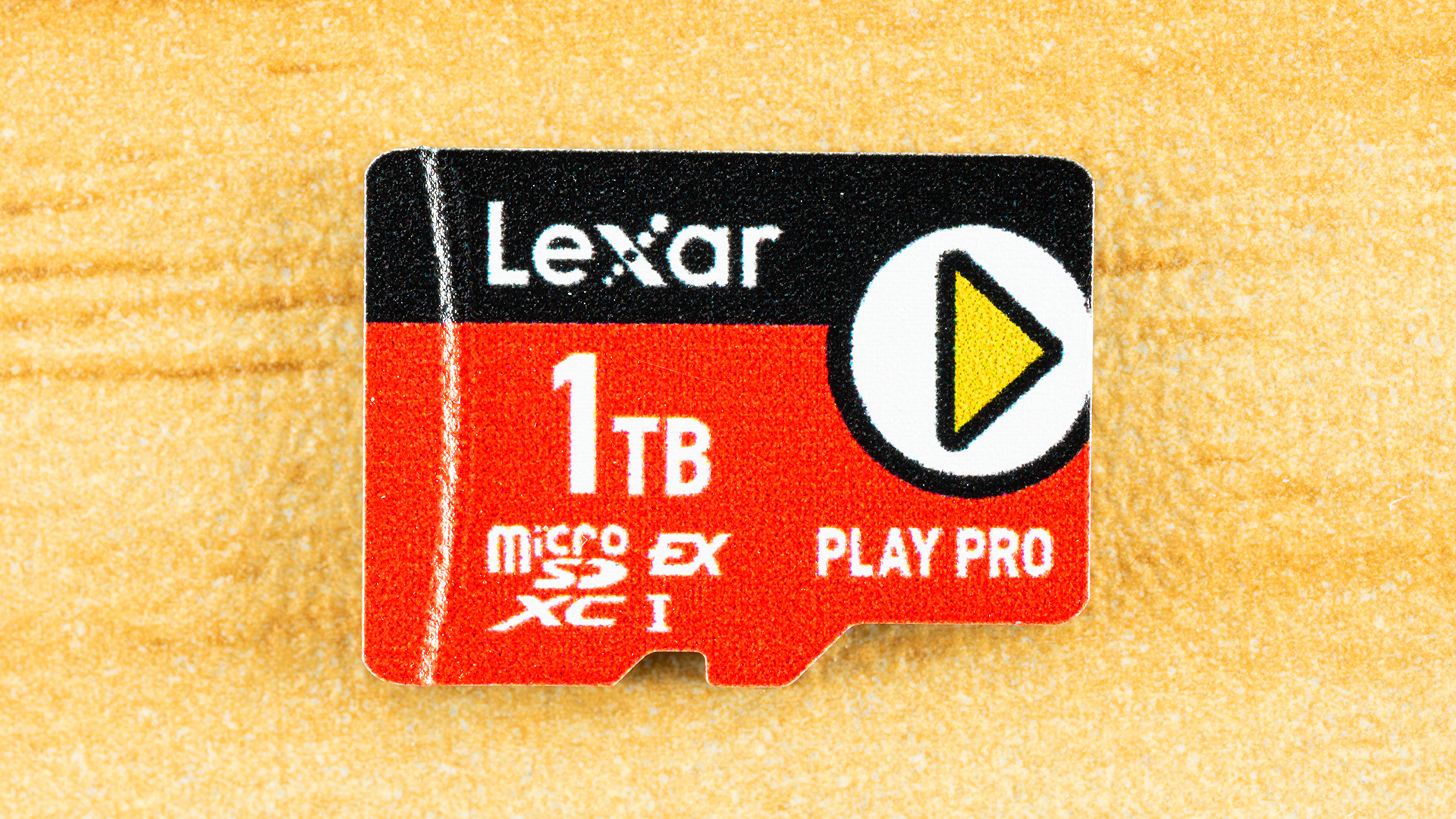
2. Lexar Play Pro 1TB
Our expert review:
Specifications
Reasons to buy
Reasons to avoid
The Lexar Play Pro 1TB is one of the best 1TB microSD Express cards for the Switch 2. It's an excellent choice if you seek the highest capacity currently available. This card is available at major U.S. retailers, offering greater convenience than some other brands. Additionally, Lexar's limited lifetime warranty enhances the product's appeal by ensuring that your investment is consistently safeguarded. These benefits come at a higher price, though. The Lexar Play Pro 1TB retails for approximately 16% above the GameStop 1TB card with similar characteristics.
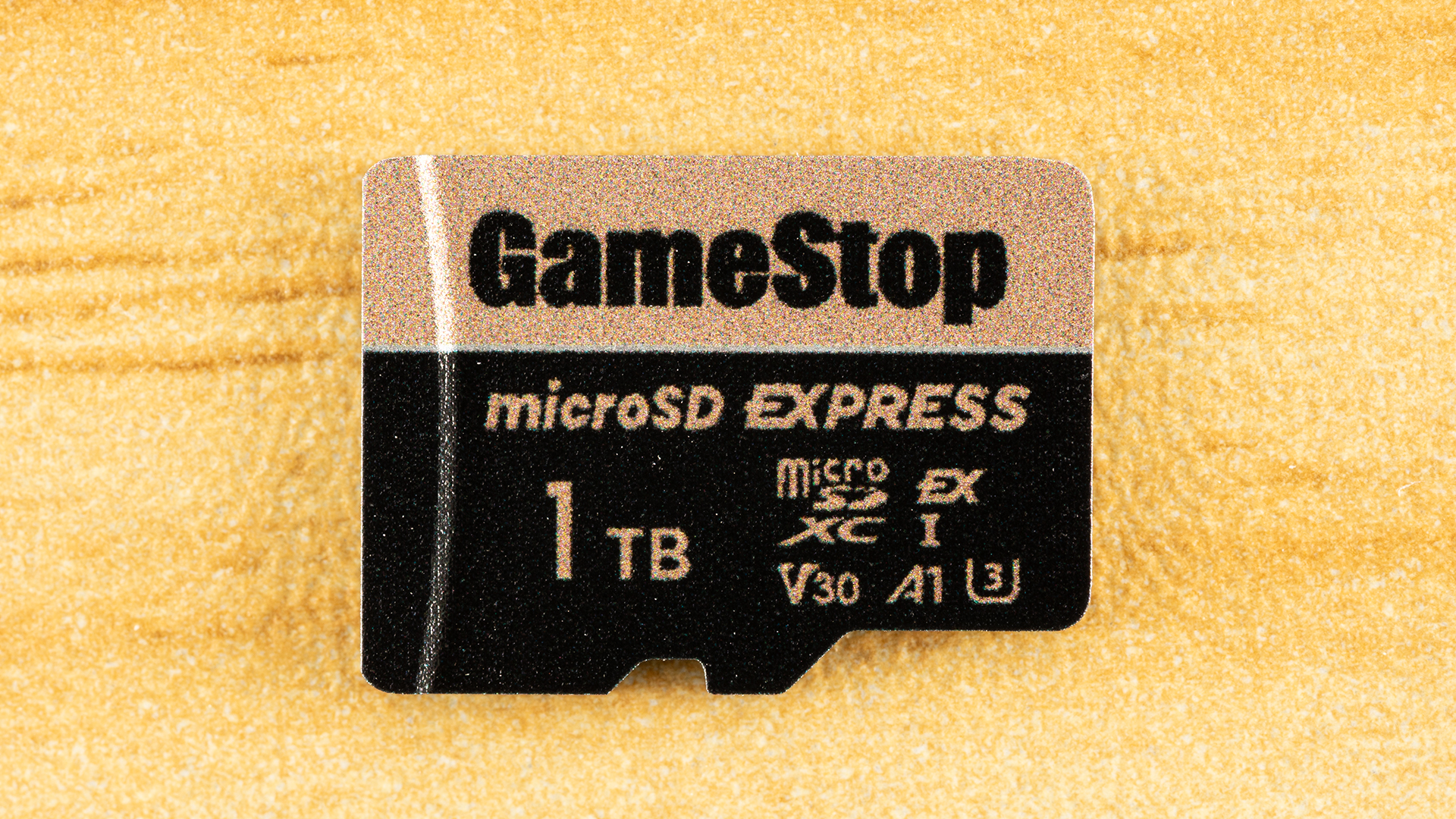
3. GameStop 1TB
Our expert review:
Specifications
Reasons to buy
Reasons to avoid
GameStop's 1TB microSD Express card is a similarly fast and spacious option as the Lexar Play Pro 1TB, making it the best budget 1TB microSD Express card on the market. One downside is that the microSD Express card is exclusive to GameStop, limiting its availability, especially outside the U.S. market. Moreover, it is noteworthy that GameStop's microSD Express card is covered by only a standard one-year manufacturer's warranty, one of the lowest on the market.
Best 512GB MicroSD Express Card
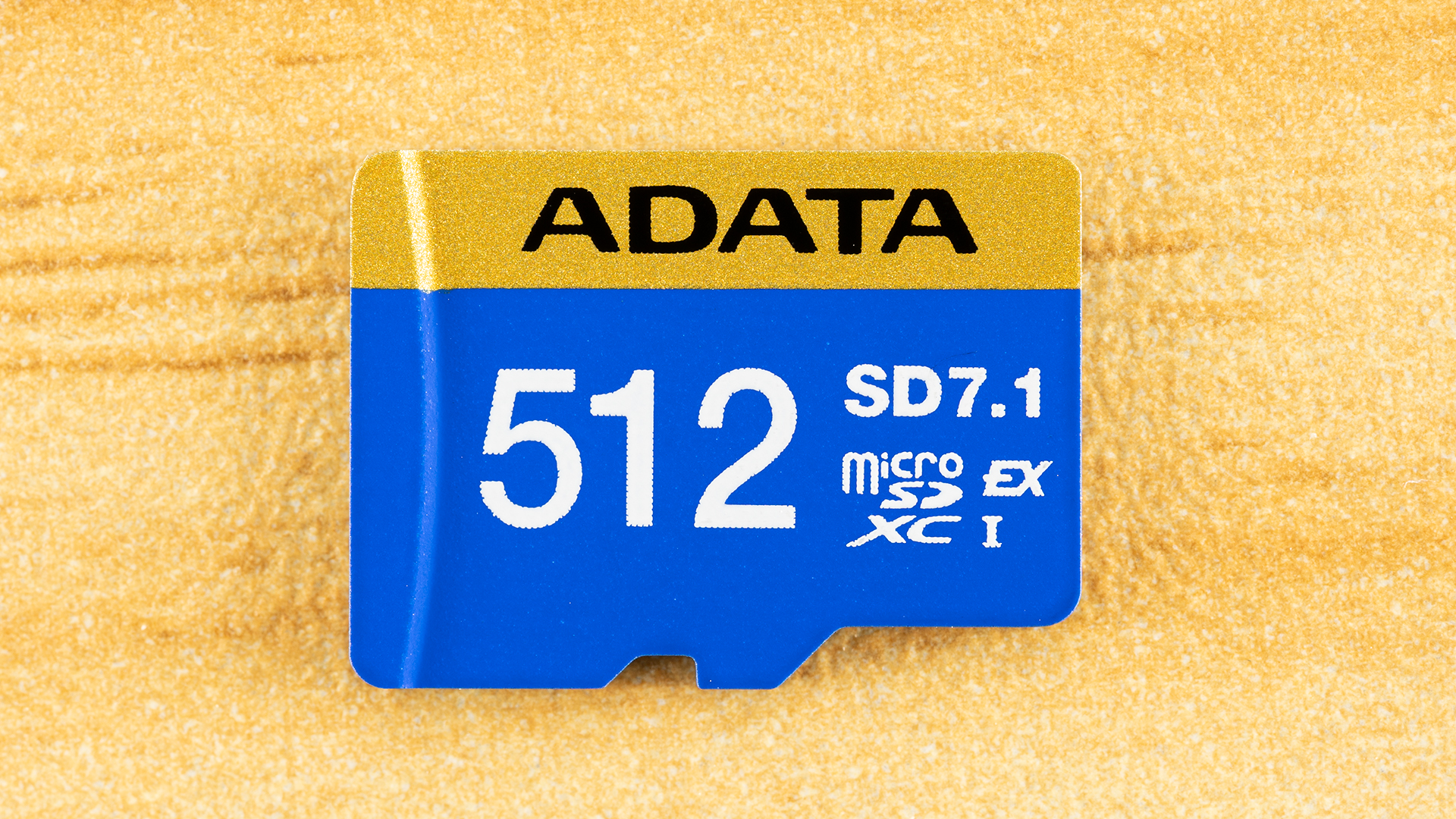
4. Adata Premier Extreme 512GB
Our expert review:
Specifications
Reasons to buy
Reasons to avoid
The Adata Premier Extreme 512GB has proven to be the fastest 512GB card we have tested to date, making it the best 512GB microSD Express card. However, this level of speed comes at a price of $129.99. However, if you want the ultimate performance, the Adata Premier Extreme 512GB is definitely one of the top options to consider.
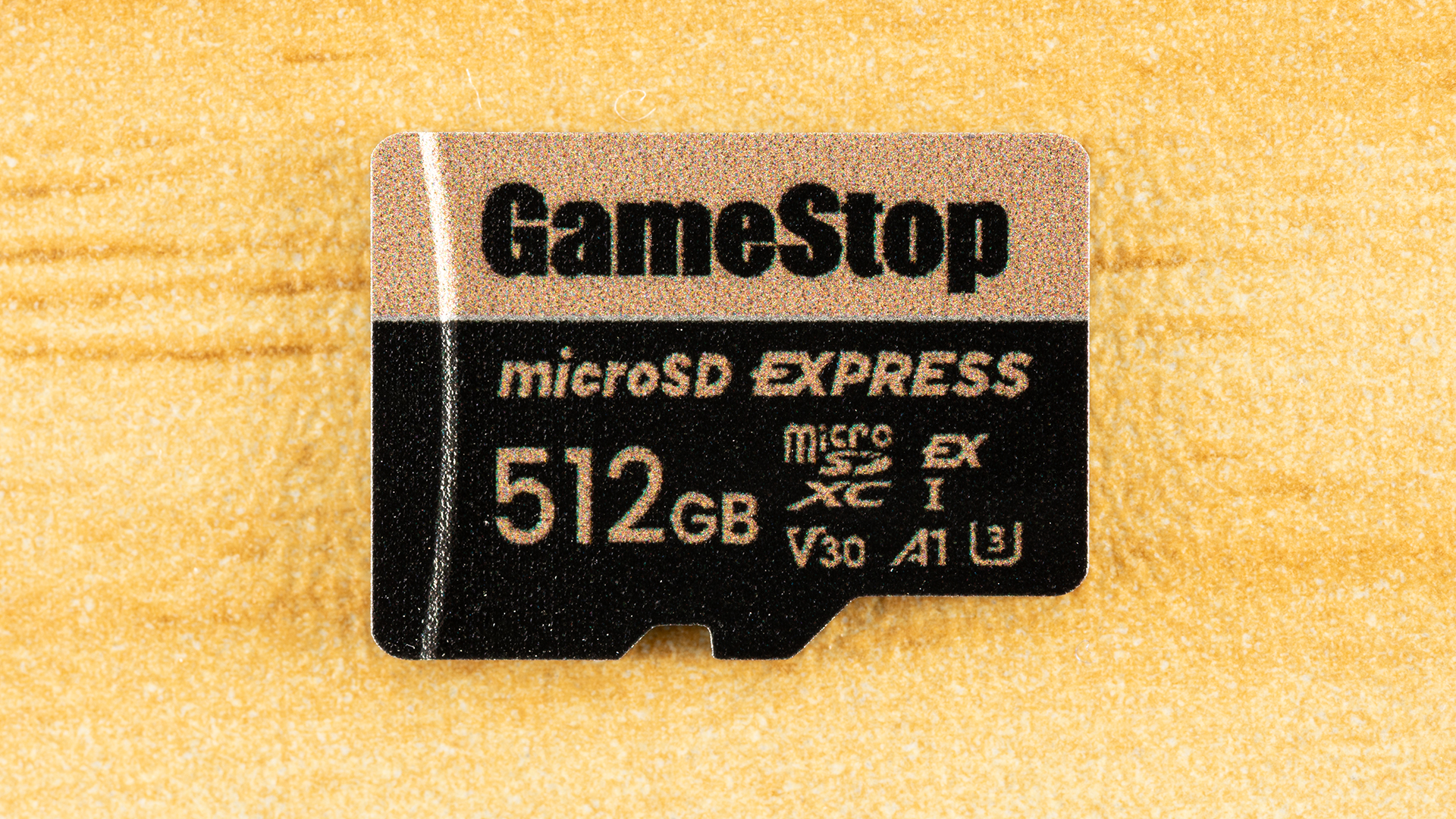
5. GameStop 512GB
Our expert review:
Specifications
Reasons to buy
Reasons to avoid
The GameStop 512GB microSD Express card is slightly slower than the Adata Premier Extreme card, but it remains a compelling option. Once again, the limitation associated with GameStop cards is that they are exclusively available at GameStop, and the warranty period is limited to one year, which can quickly pass.
Best 256GB MicroSD Express Card
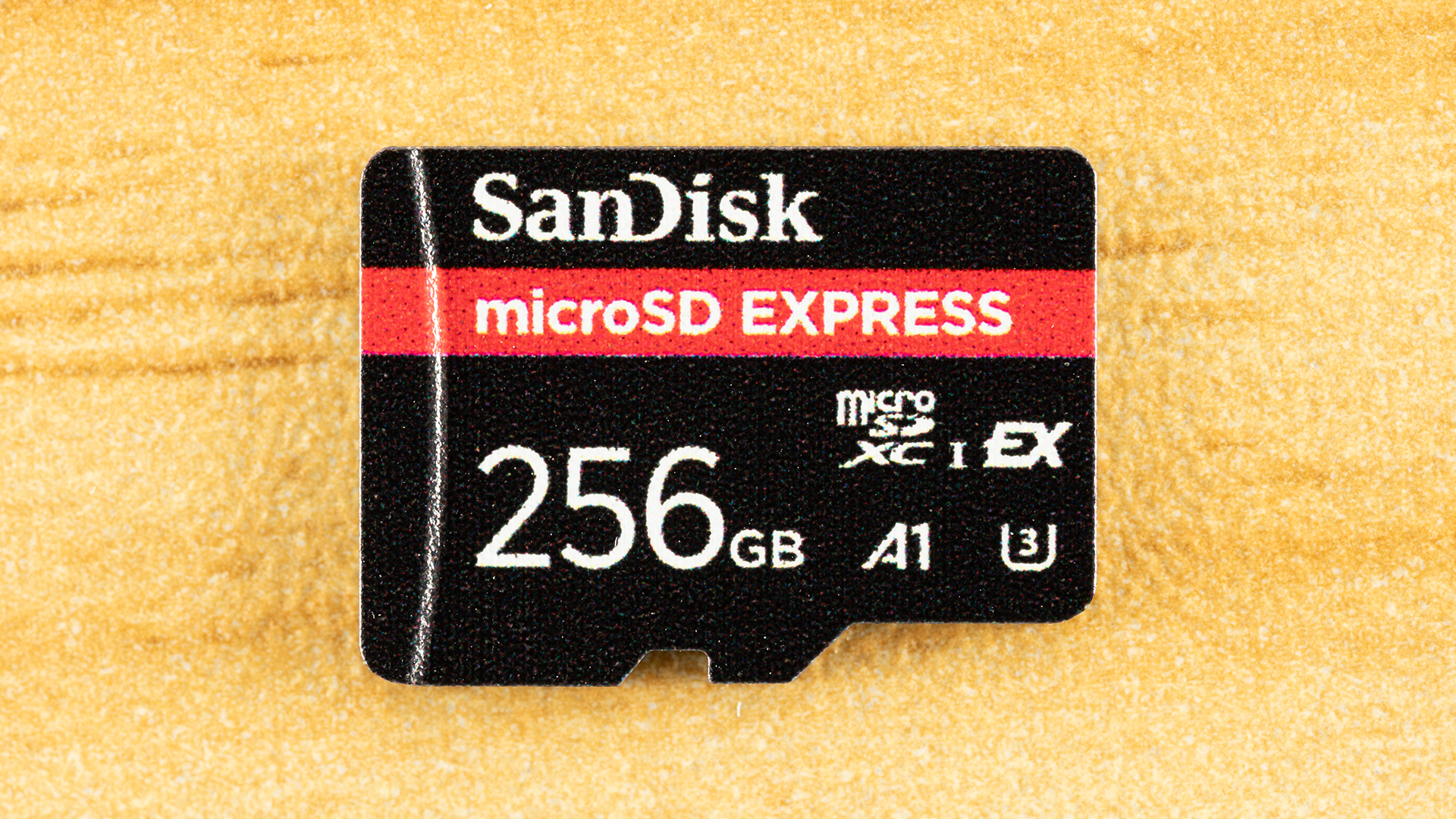
6. Sandisk 256GB
Our expert review:
Specifications
Reasons to buy
Reasons to avoid
The Sandisk 256GB microSD Express card's performance is exemplary, making it the best 256GB microSD Express card on the market. At $71.99, the Sandisk card isn't easy on the pocket, but it does flaunt excellent performance and a lifetime warranty.
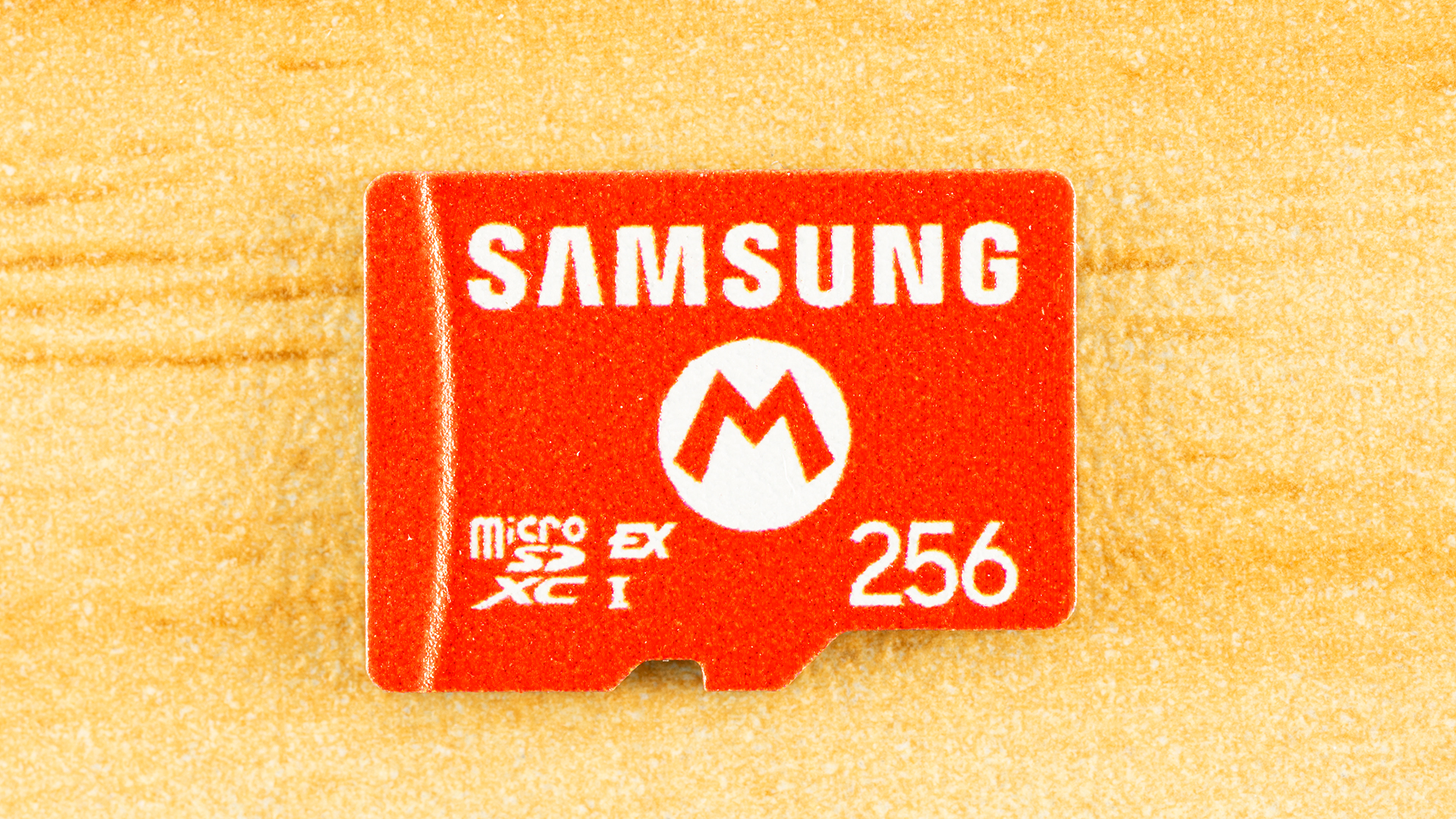
7. Samsung Super Mario Edition 256GB
Our expert review:
Specifications
Reasons to buy
Reasons to avoid
The Samsung Super Mario Edition 256GB card is the only officially licensed Nintendo microSD Express card for the Switch 2. Although it doesn't exhibit chart-topping performance, it serves as the best alternative 256GB microSD Express card for budget-conscious Switch 2 users who do not prioritize maximum performance. It only has a three-year warranty. Although it is not a lifetime warranty, it still provides two more years of warranty coverage than GameStop cards.
Best 128GB MicroSD Express Card
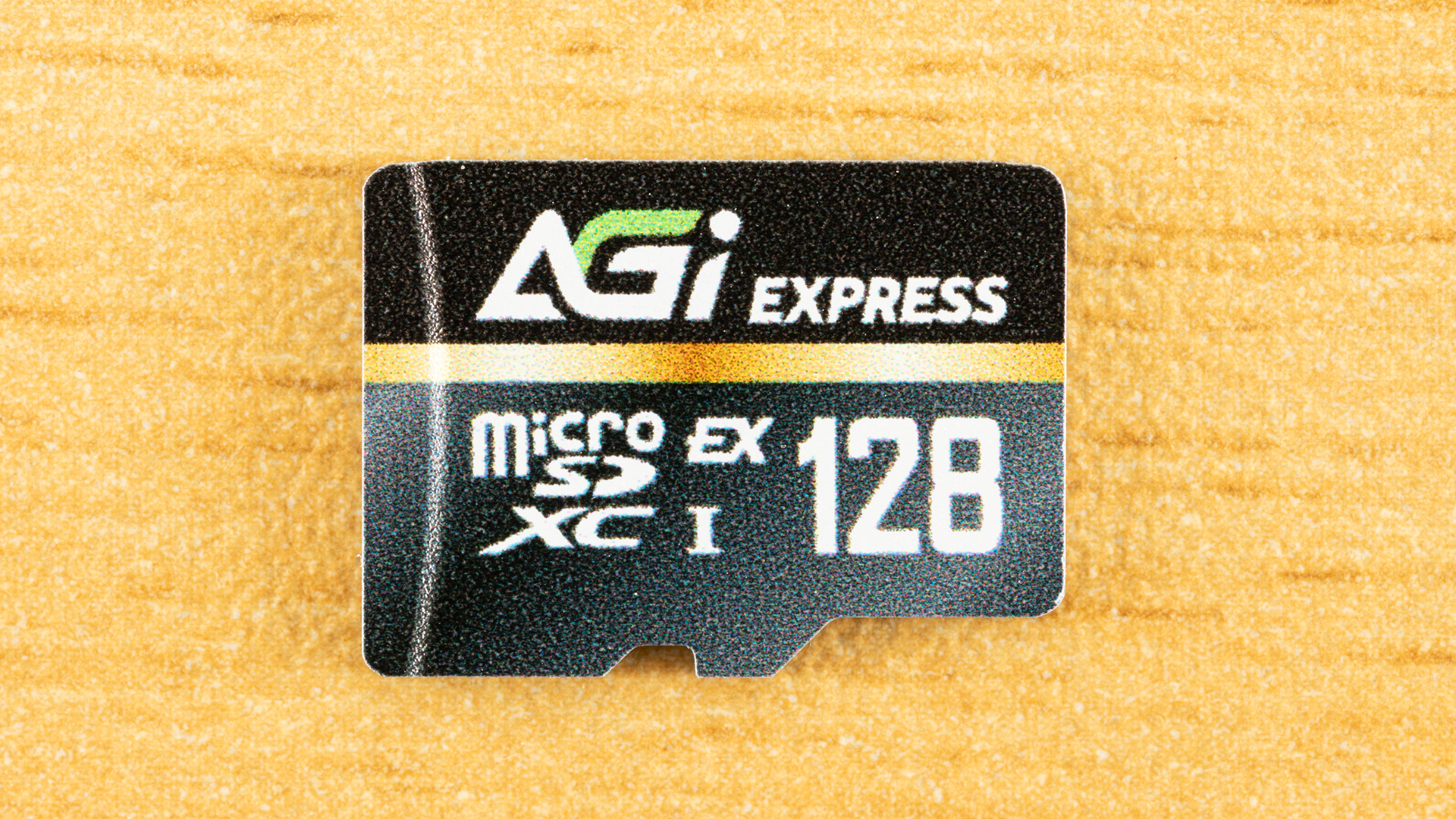
8. AGI TF338 128GB
Our expert review:
Specifications
Reasons to buy
Reasons to avoid
The AGI TF338 is a mixed bag in terms of performance. The AGI TF338 is relatively difficult to obtain and commands a substantial price because it ships from Amazon Japan. The AGI offers a limited five-year warranty on the product, which surpasses the standard three- or one-year warranties provided by other brands.
MicroSD Express Card Hierarchy
Our hierarchy ranks each microSD Express card that has undergone extensive benchmarking in our lab, which is then organized by capacity. The overall throughput result represents the geometric mean of the bandwidth tests conducted using our storage benchmark suite. Conversely, the other results derive from real-world testing in the actual Switch 2. The hierarchy will expand as we proceed to test additional microSD Express cards in the future.
1TB MicroSD Express Cards
MicroSD Express Card | Price | Copy Speed To Card (MB/s) | Copy Speed From Card (MB/s) | Mario Kart World (Seconds) | Pokemon Legends: Z-A (Seconds) | Overall Throughput | PN / UPC |
|---|---|---|---|---|---|---|---|
TeamGroup Apex SD7.1 1TB | 91.92 | 108.52 | 18.8 | 6.3 | 399.2 | TAPMSDE1TIV30A102 | |
GameStop 1TB | 91.45 | 107.63 | 21.0 | 6.3 | 397.2 | 25VG-GSPL-EXPMICROSDCARD-1TB | |
Lexar Play Pro 1TB | 91.36 | 108.63 | 18.4 | 6.3 | 397.4 | LMSXPS0001T- BNNNU |
512GB MicroSD Express Cards
MicroSD Express Card | Price | Copy Speed To Card (MB/s) | Copy Speed From Card (MB/s) | Mario Kart World (Seconds) | Pokemon Legends: Z-A (Seconds) | Overall Throughput | PN / UPC |
|---|---|---|---|---|---|---|---|
Adata Premier Extreme 512GB | 93.72 | 108.75 | 20.9 | 6.3 | 309.1 | UD512GEX3L1-C | |
GameStop 512GB | 80.34 | 108.80 | 21.0 | 6.3 | 395.8 | 25VG-GSPL-EXPMICROSDCARD-512GB | |
AGI TF338 512GB | N/A | 79.75 | 114.31 | 20.8 | 6.2 | 470.0 | AGI512GE1TF338-CB |
256GB MicroSD Express Cards
MicroSD Express Card | Price | Copy Speed To Card (MB/s) | Copy Speed From Card (MB/s) | Mario Kart World (Seconds) | Pokemon Legends: Z-A (Seconds) | Overall Throughput | PN / UPC |
|---|---|---|---|---|---|---|---|
Adata Premier Extreme 256GB | 84.10 | 114.31 | 21.1 | 6.3 | 320.7 | UD256GEX3L1-C | |
Sandisk 256GB | 79.49 | 109.52 | 20.5 | 6.2 | 410.8 | SDSQXFN-256G-GN4NN | |
Samsung Super Mario Edition 256GB | 71.53 | 105.34 | 21.5 | 6.4 | 281.0 | MB-MZ256S | |
GameStop 256GB | 71.32 | 109.68 | 21.6 | 6.4 | 277.2 | 25VG-GSPL-EXPMICROSDCARD-256GB | |
AGI TF338 256GB | 50.56 | 113.46 | 18.9 | 6.2 | 398.1 | AGI256GE1TF338-CB |
128GB MicroSD Express Cards
MicroSD Express Card | Price | Copy Speed To Card (MB/s) | Copy Speed From Card (MB/s) | Mario Kart World (Seconds) | Pokemon Legends: Z-A (Seconds) | Overall Throughput | PN / UPC |
|---|---|---|---|---|---|---|---|
AGI TF338 128GB | 39.33 | 113.58 | 18.7 | 6.2 | 294.0 | AGI128GE1TF338-CB |
MicroSD Express Card Performance Charts
Nintendo Switch 2 Benchmarks




PC Storage Benchmarks
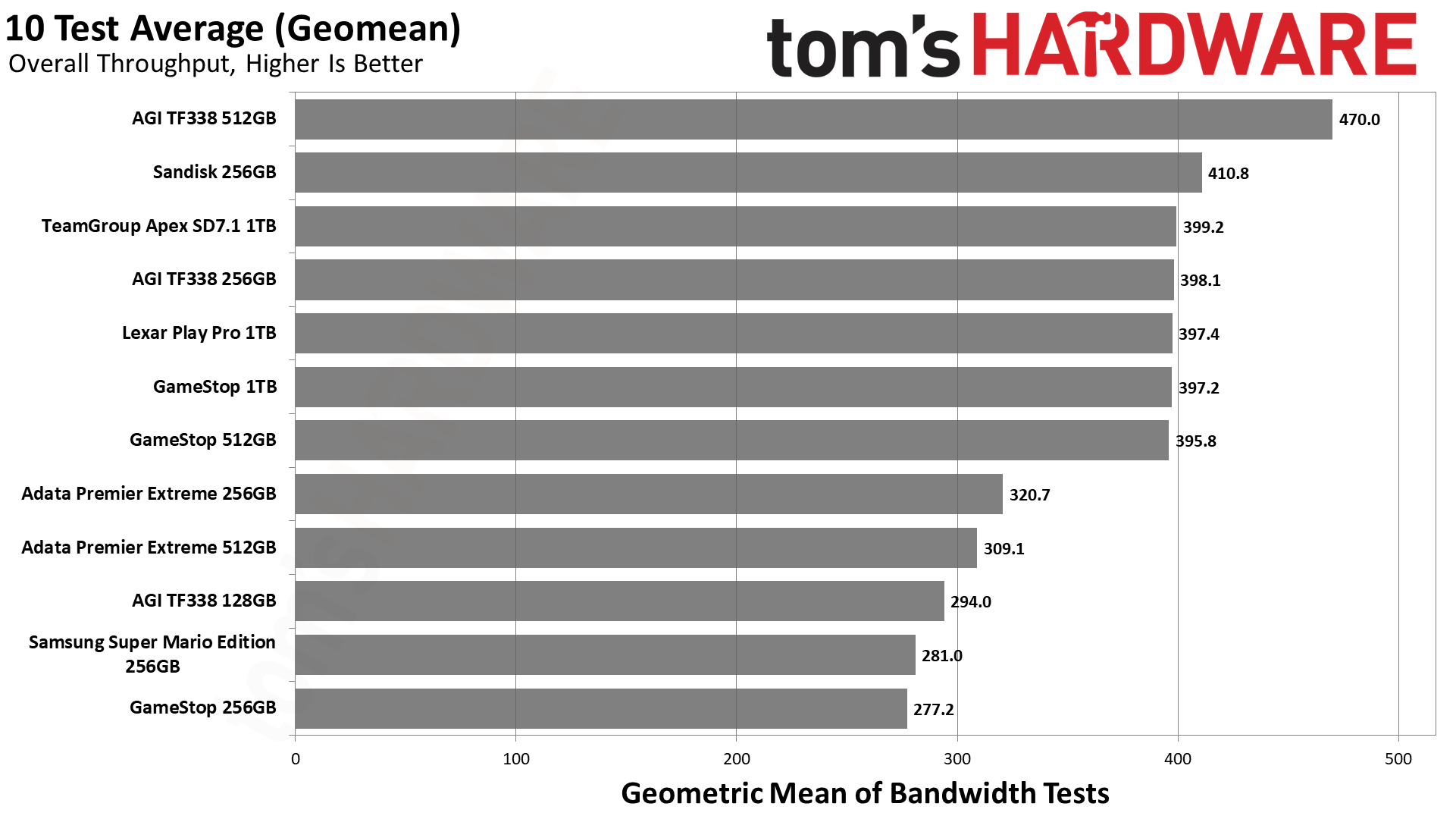
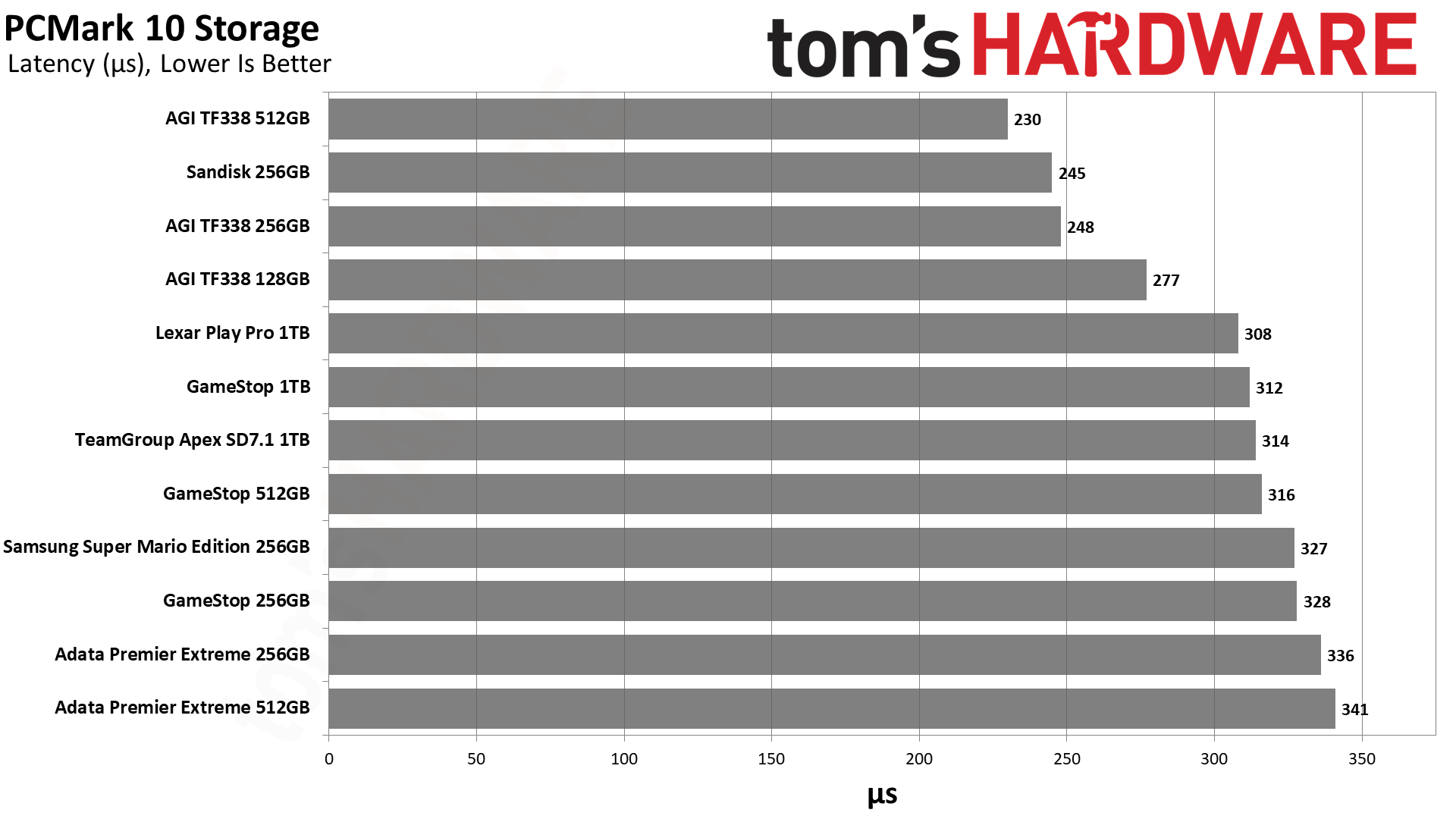
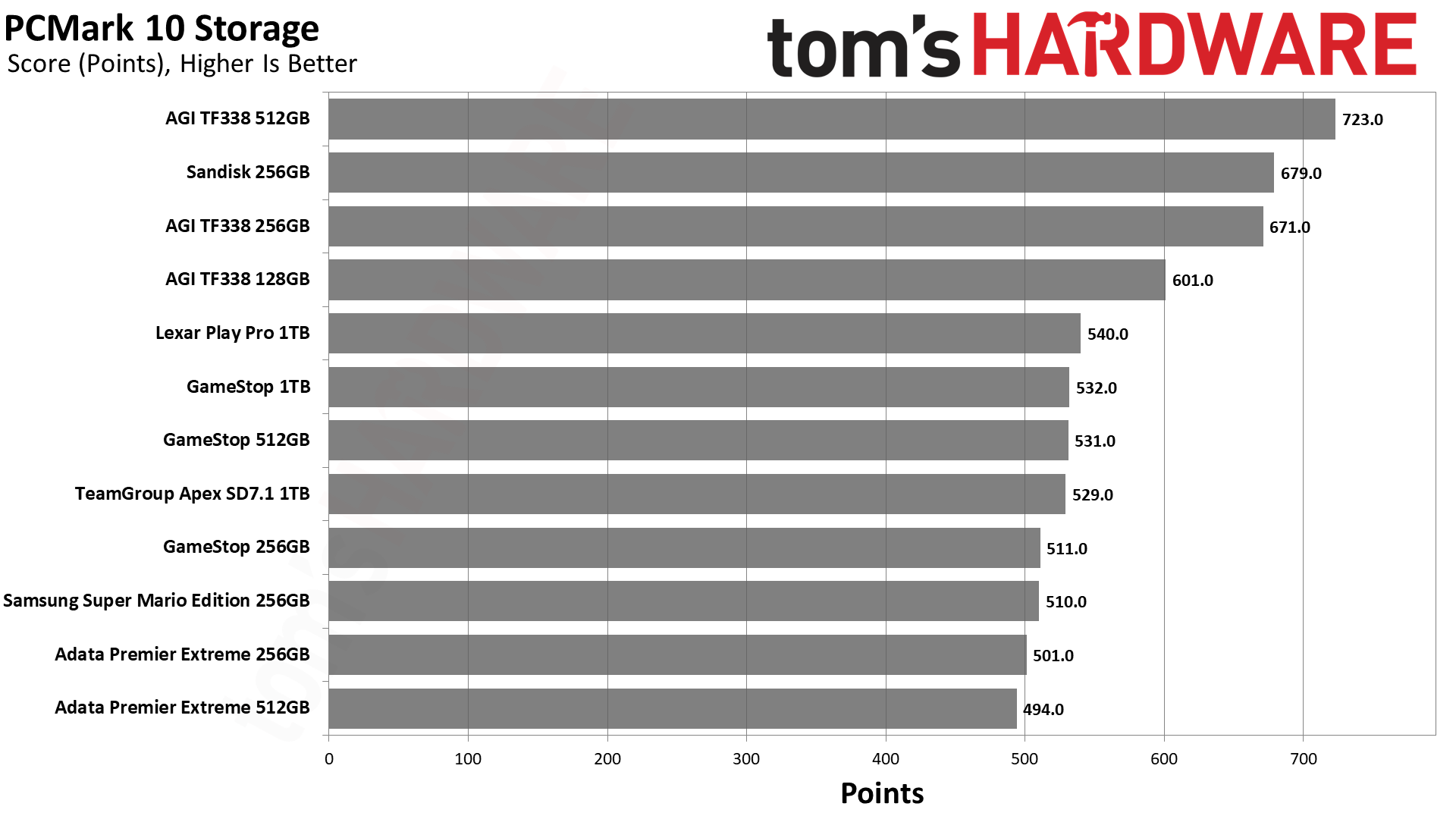
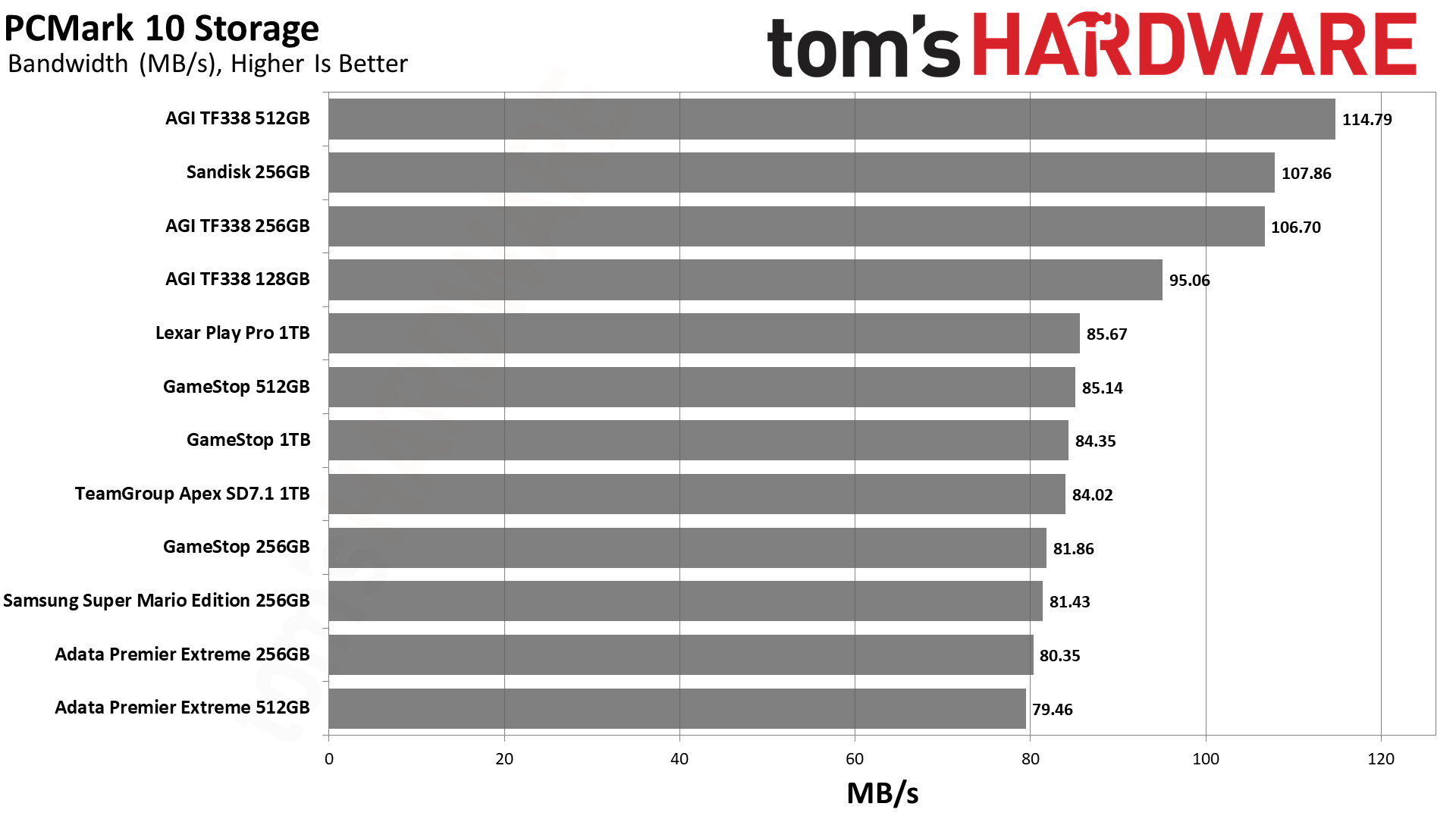
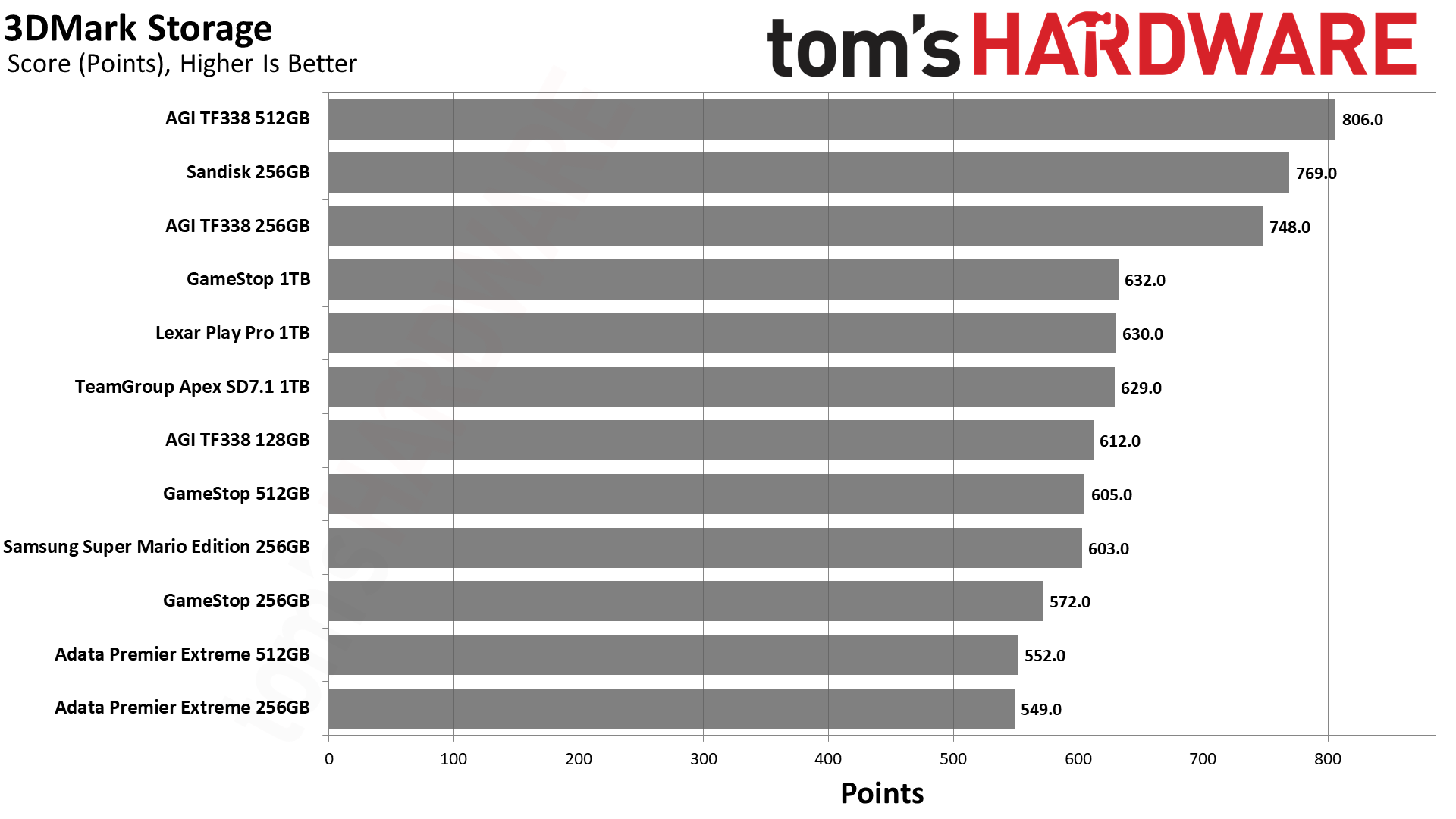
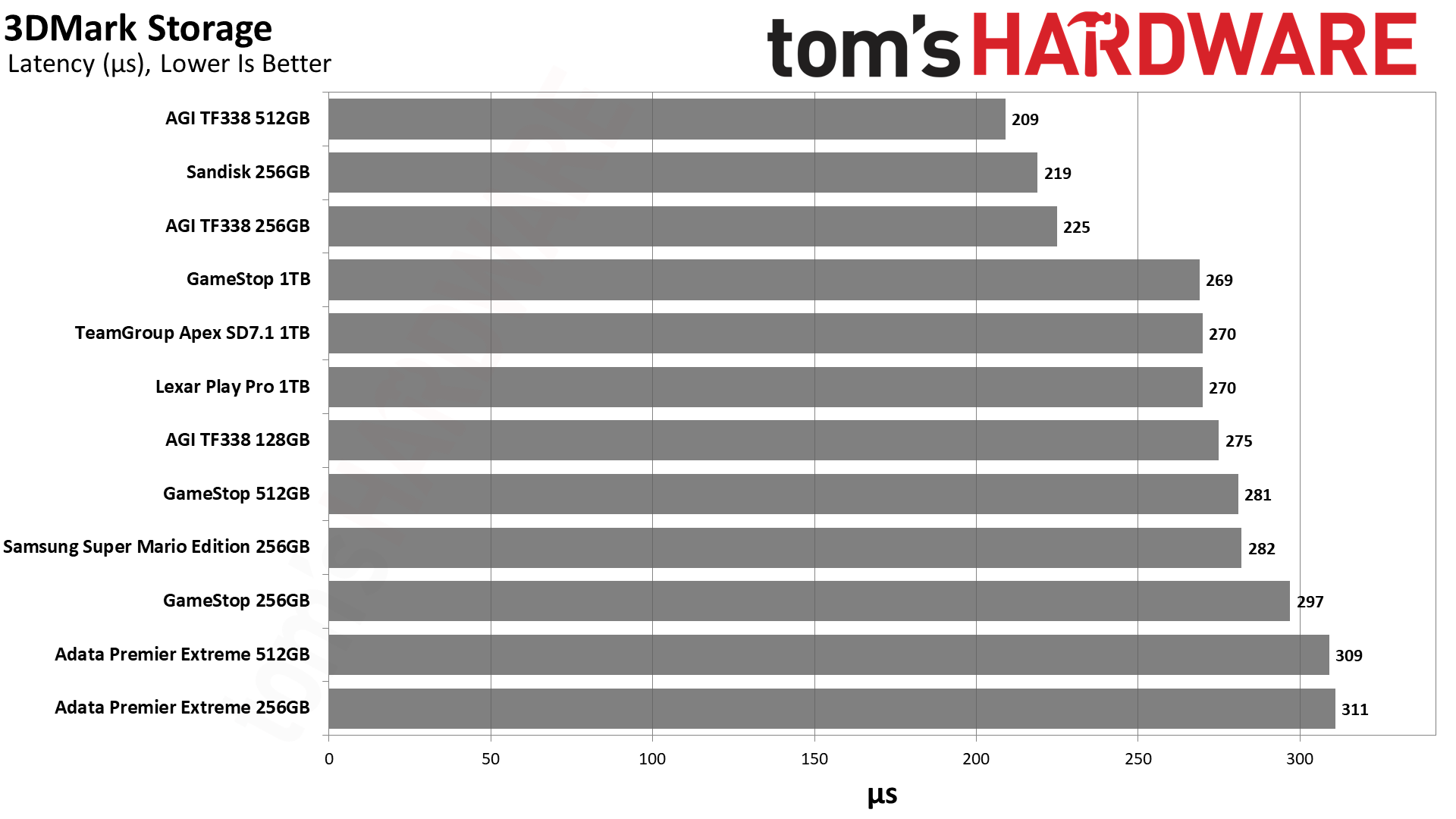
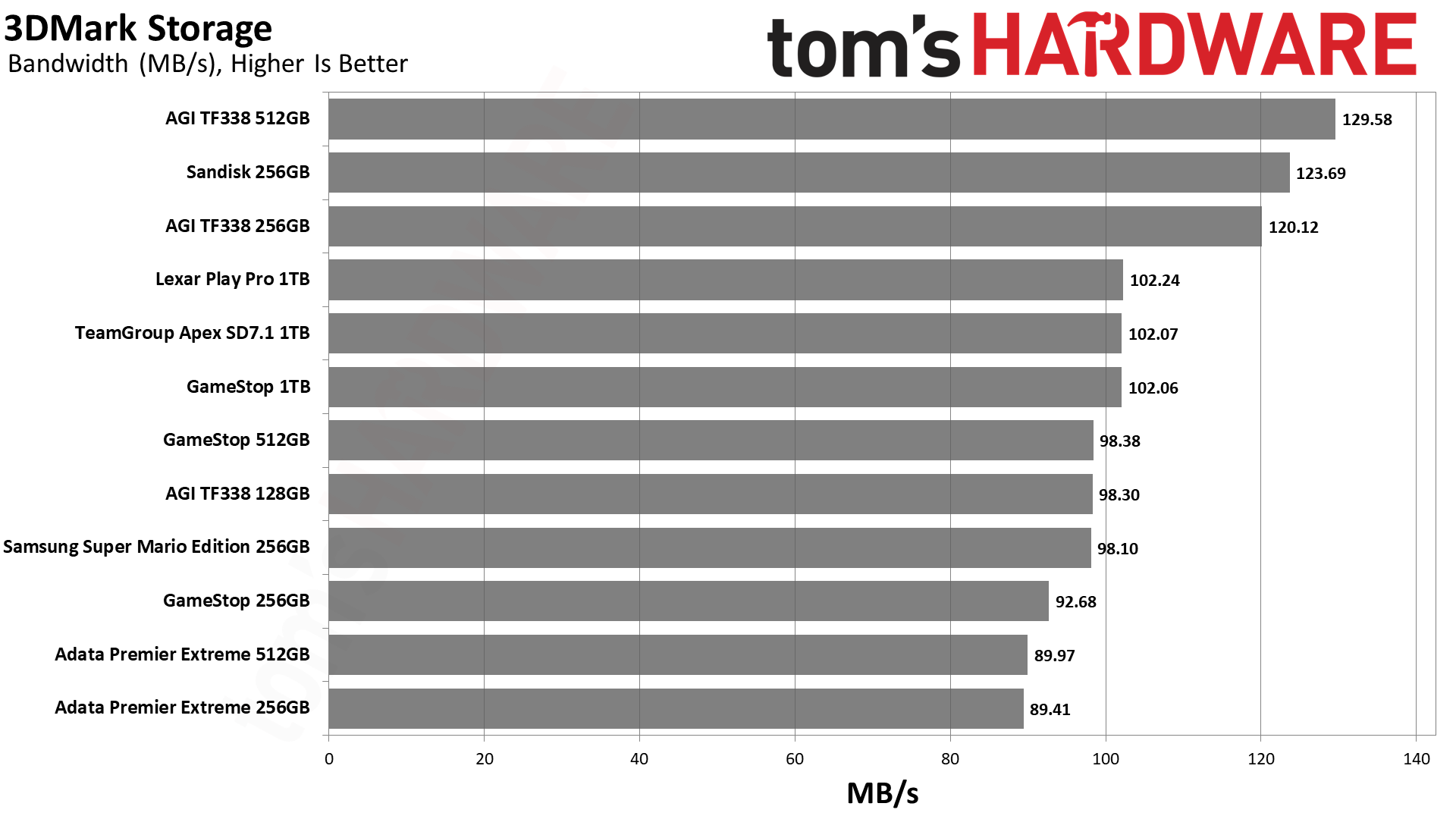
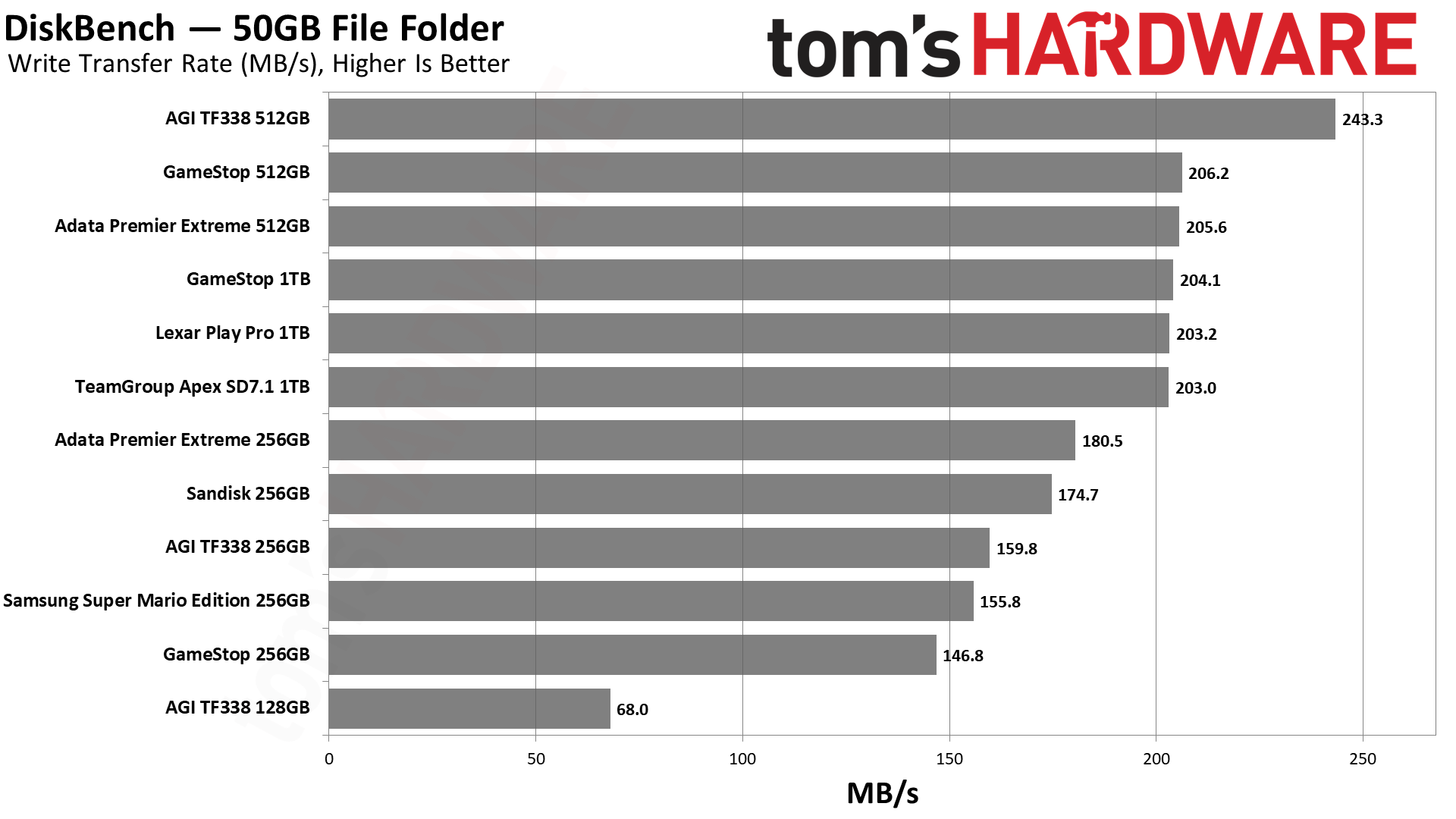
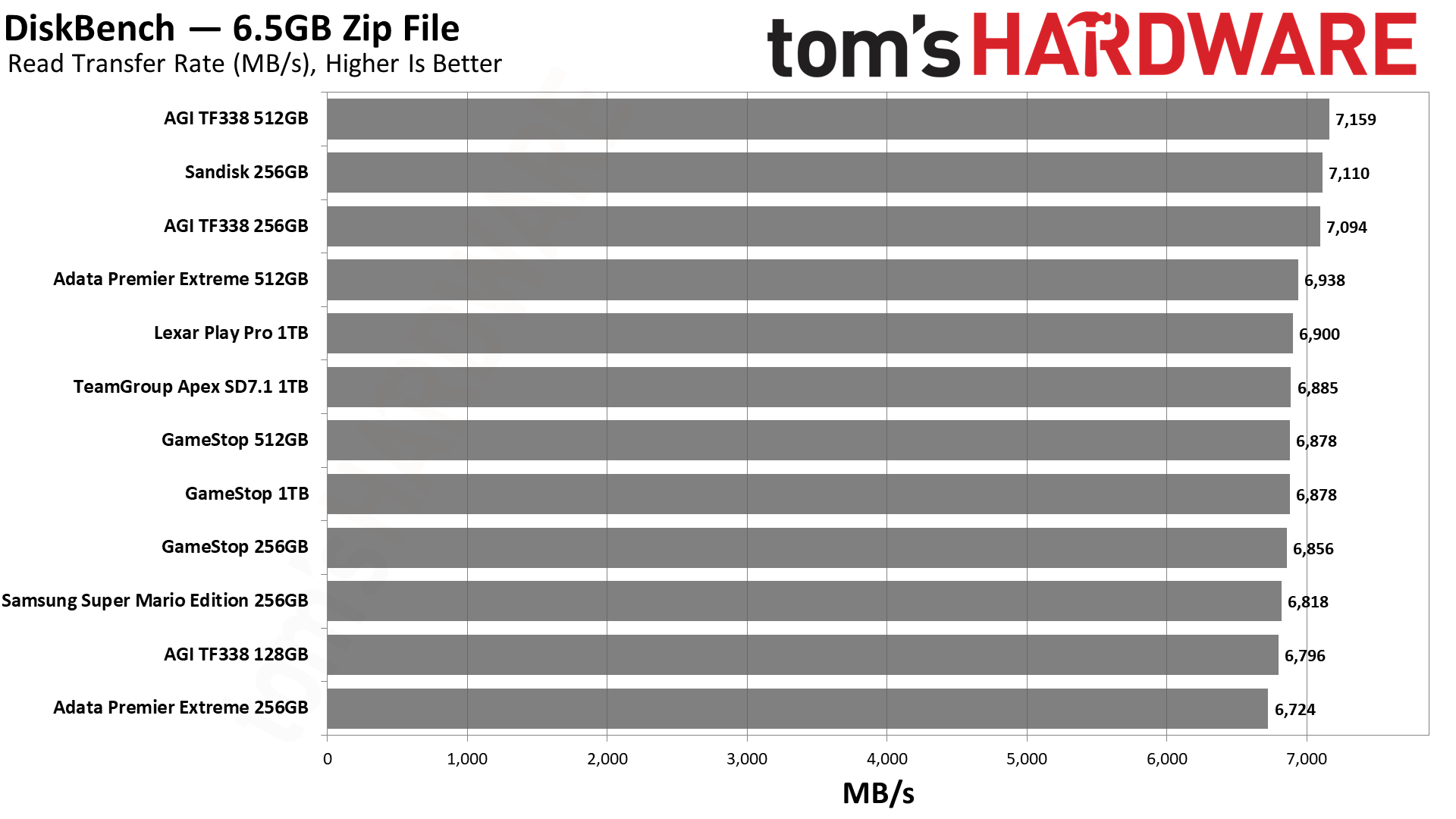
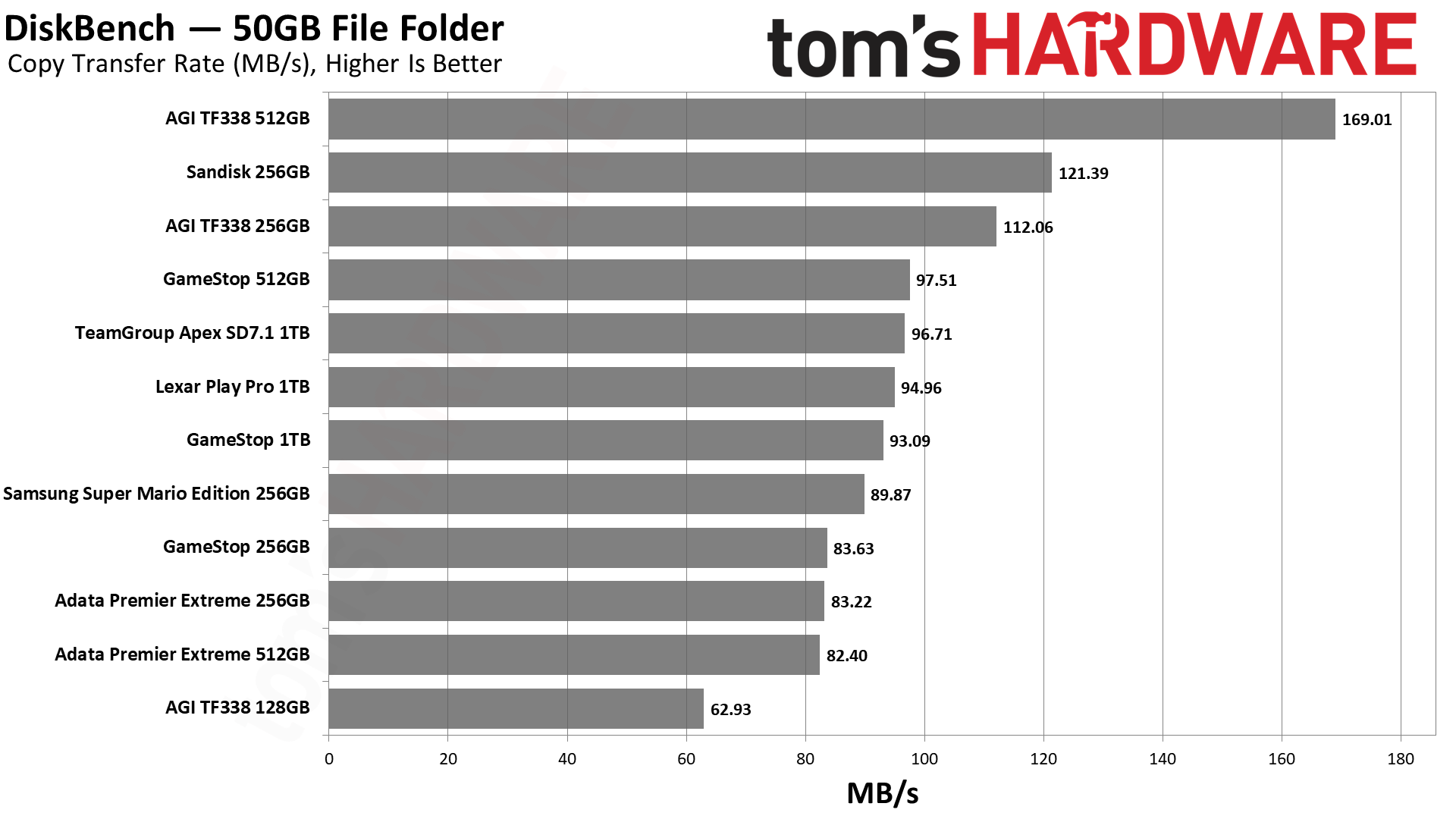
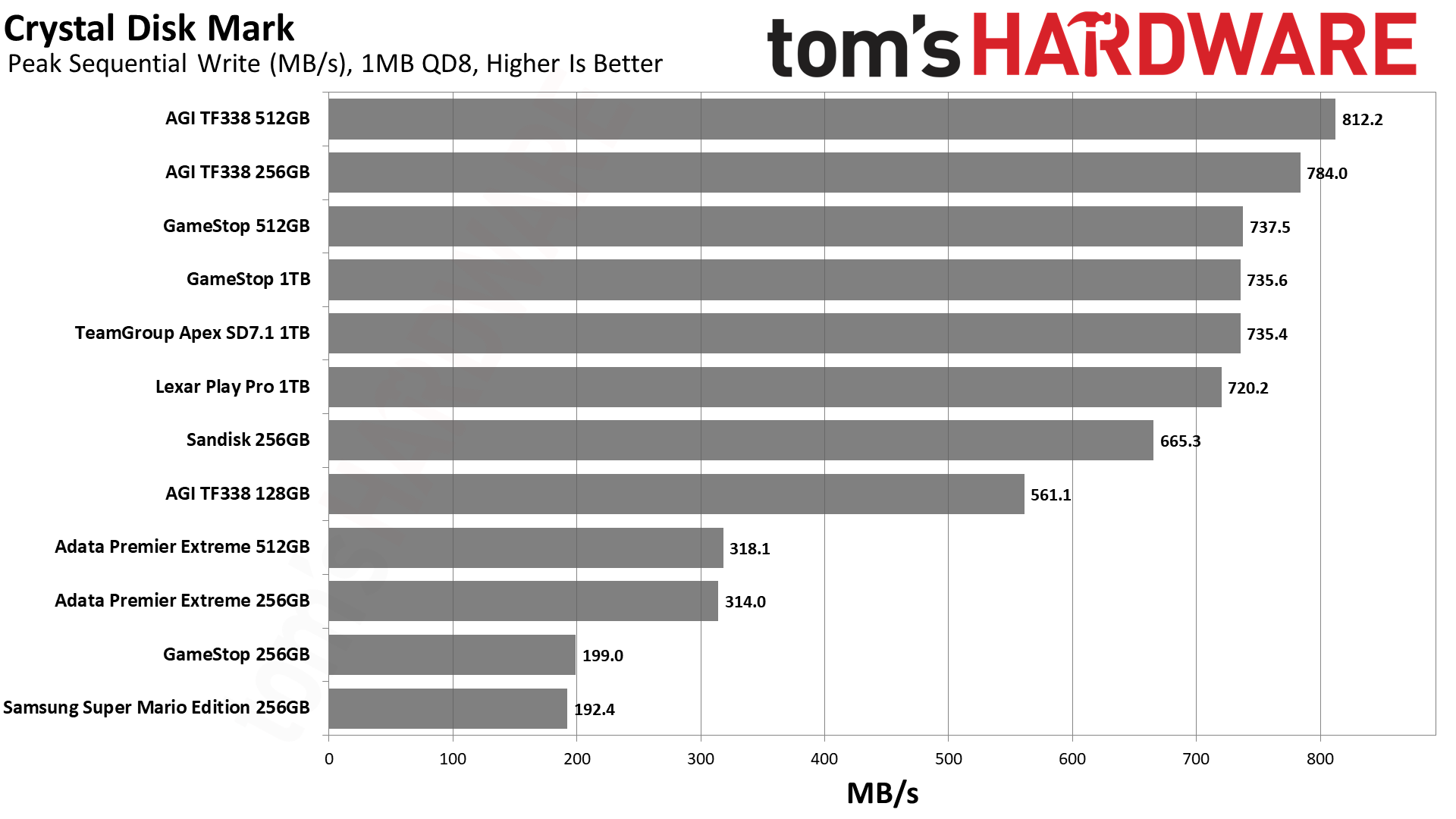
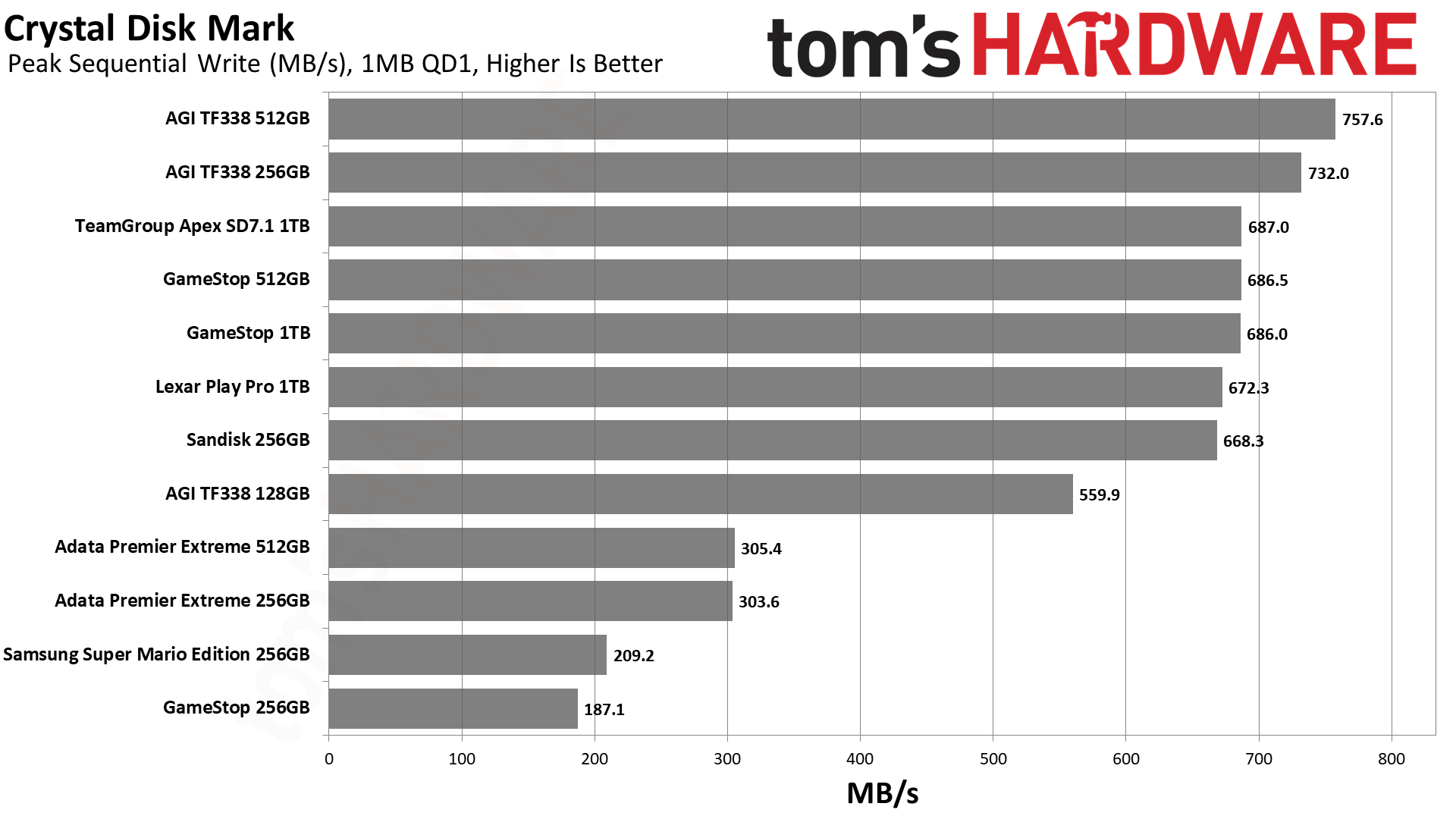
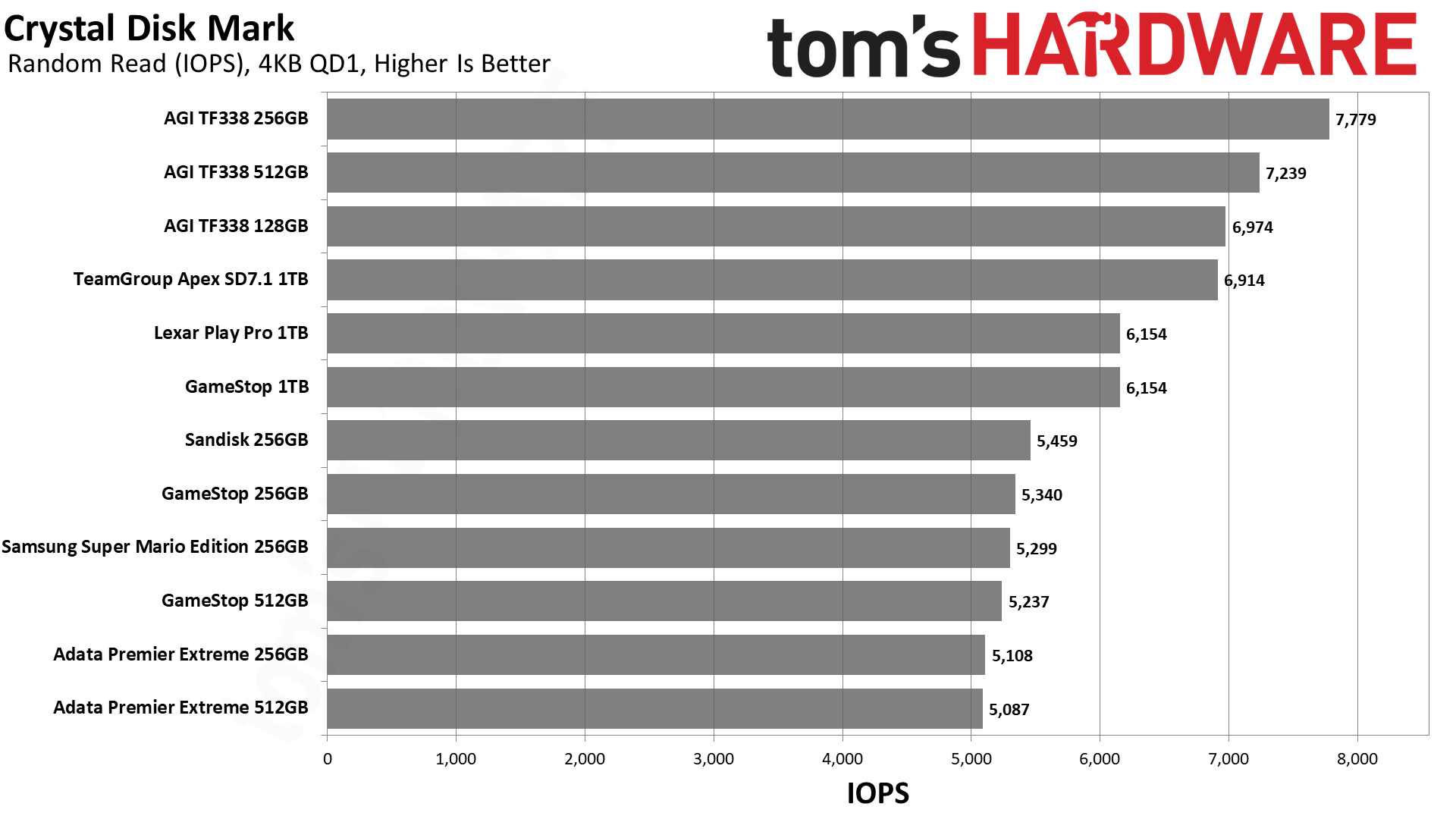
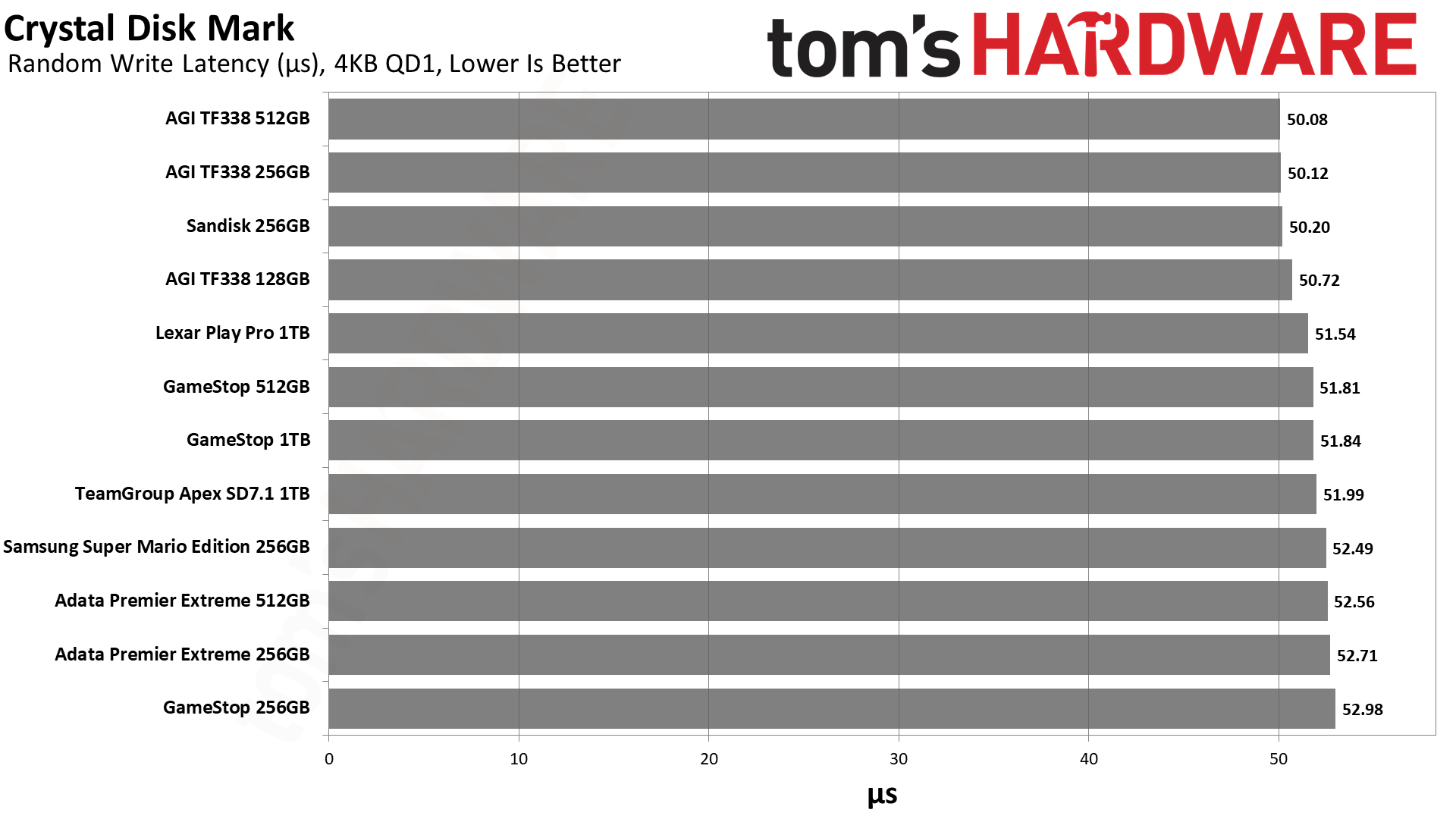
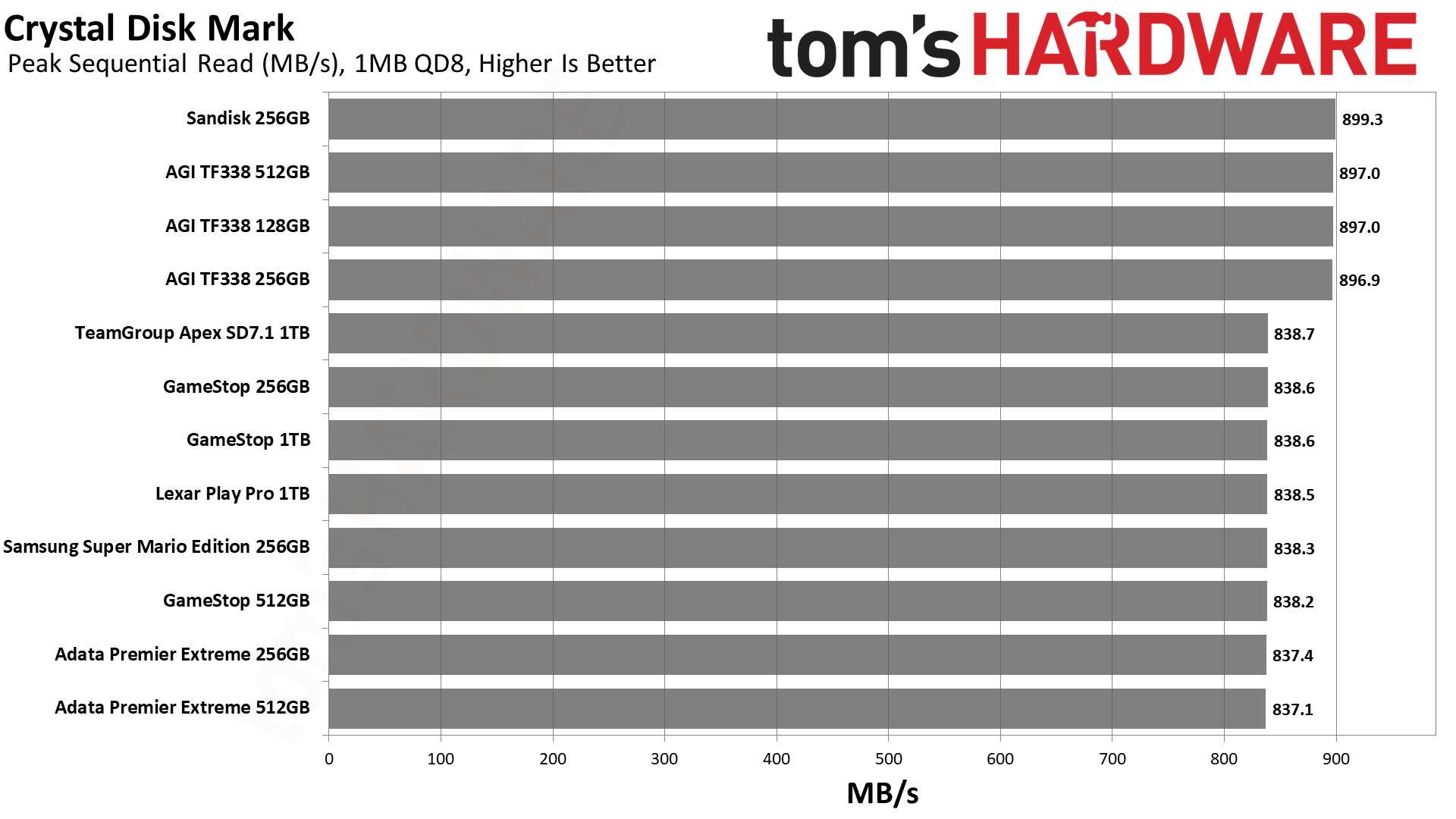
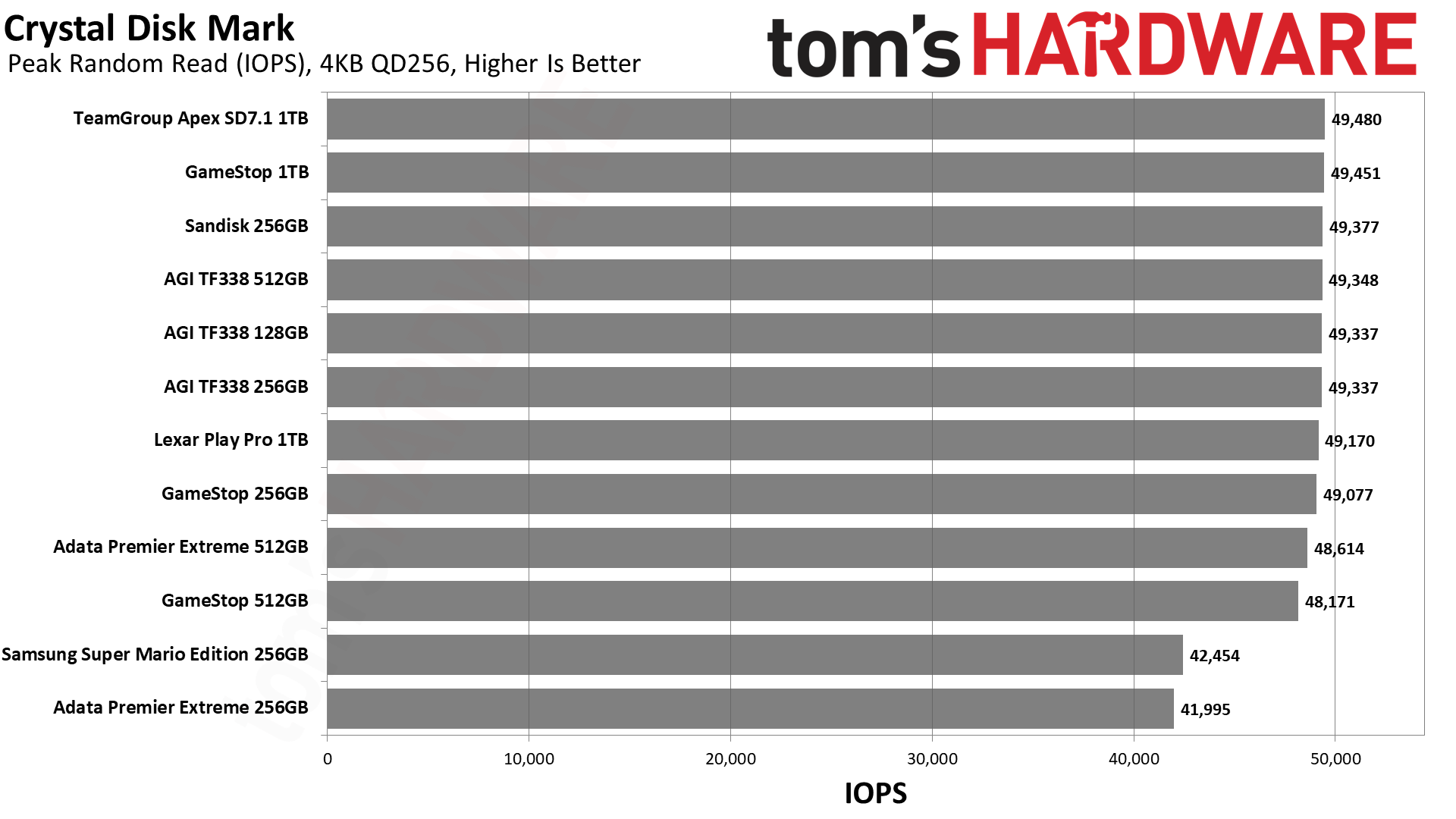
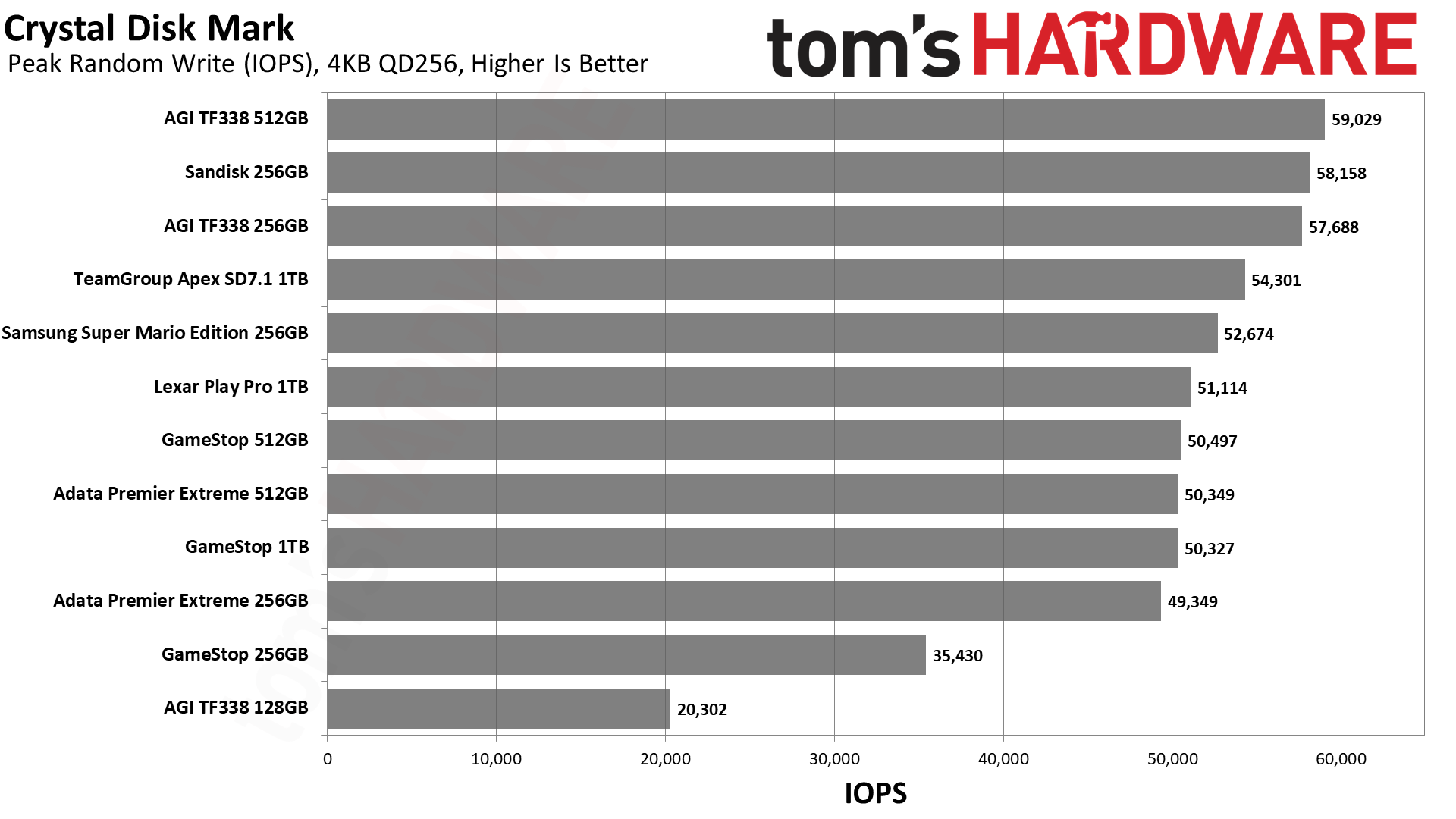
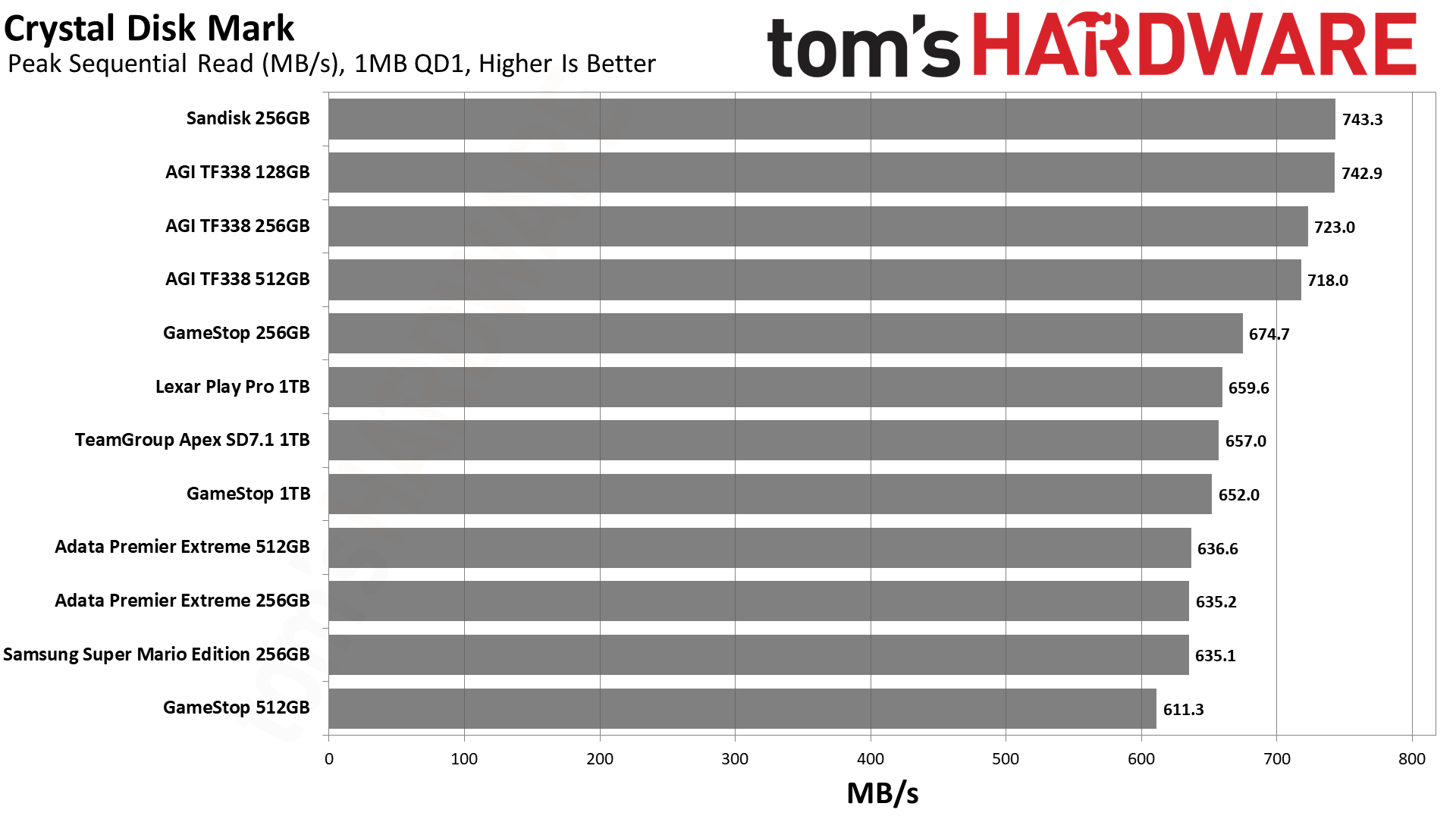
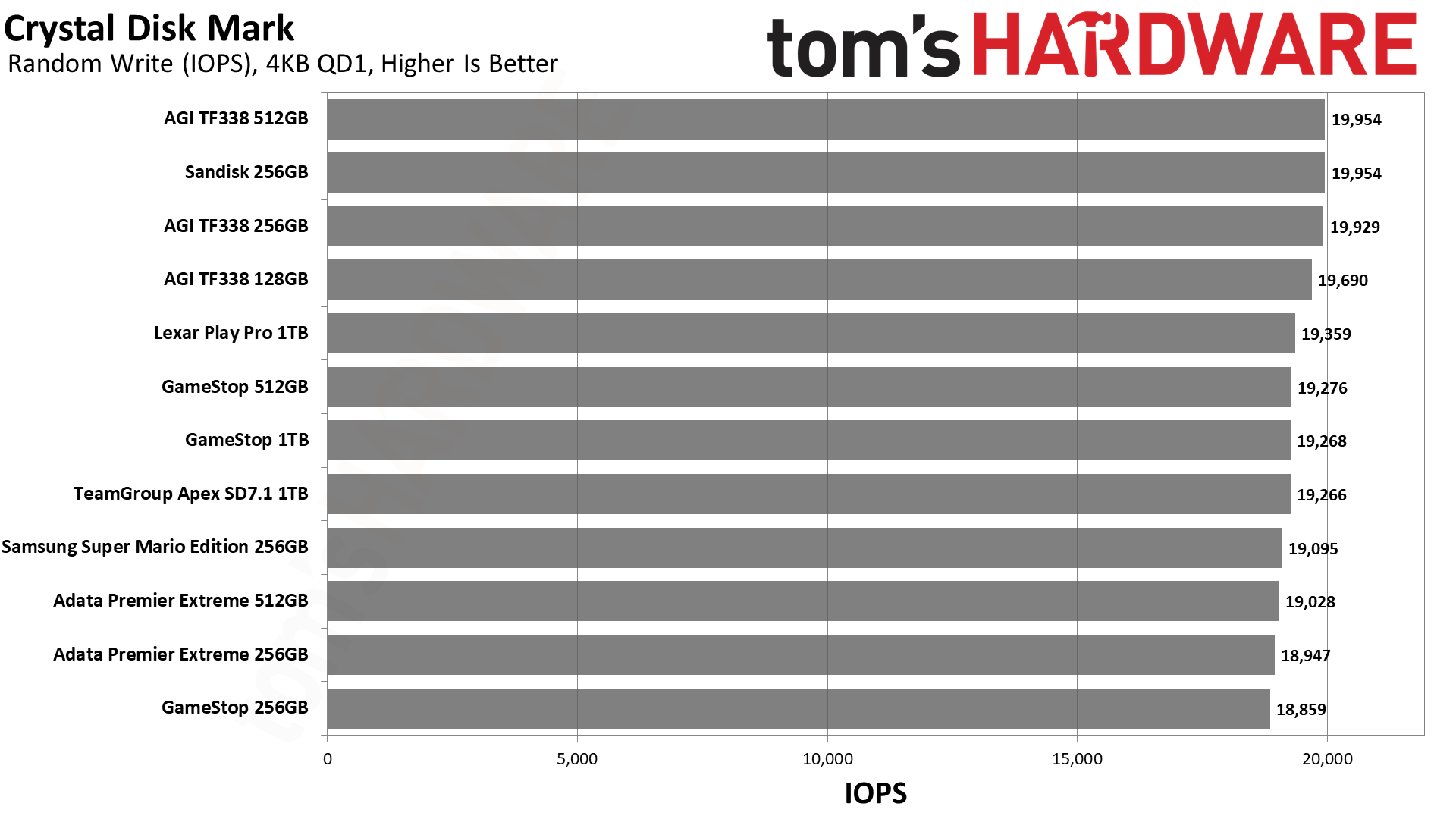
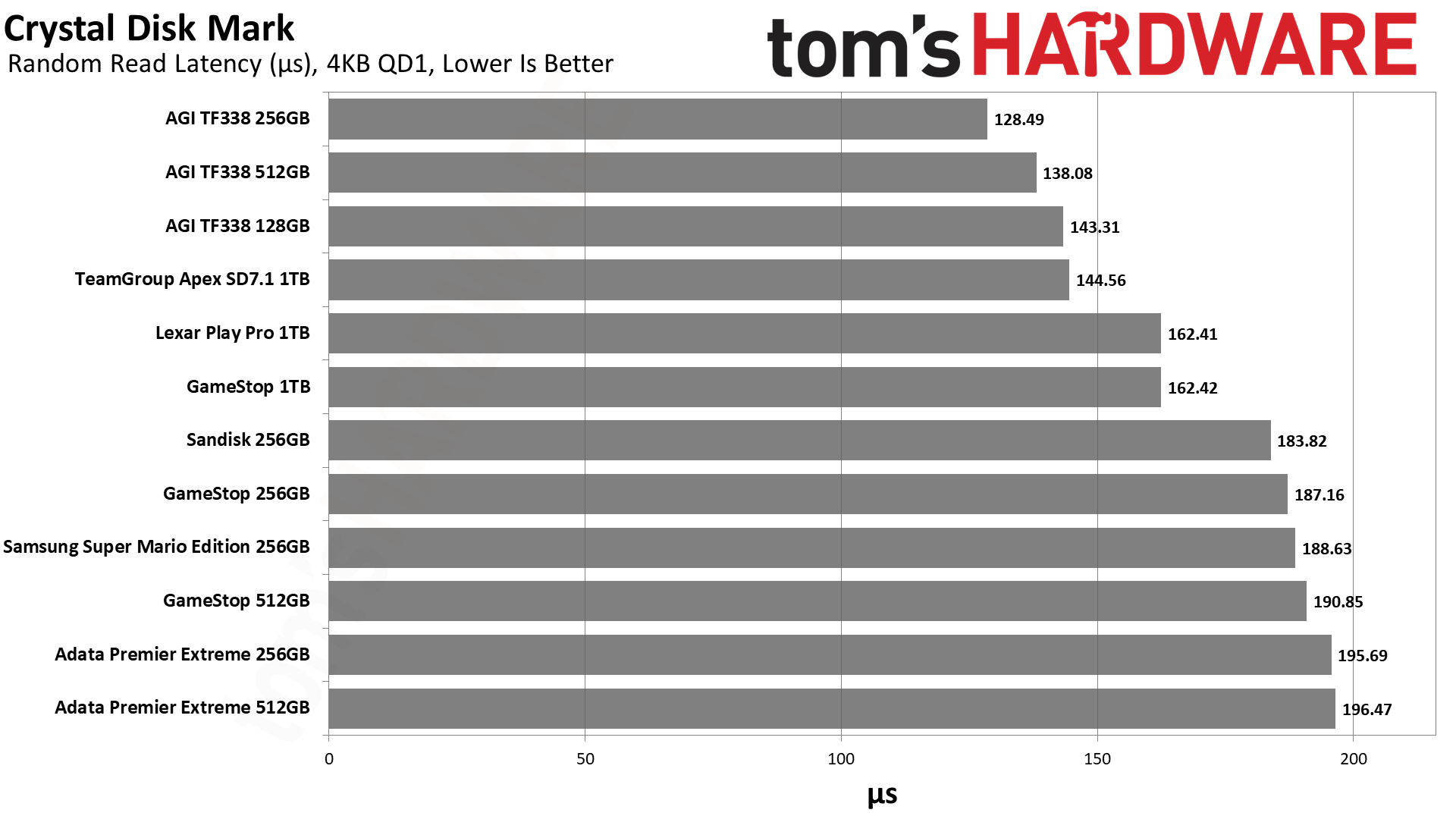
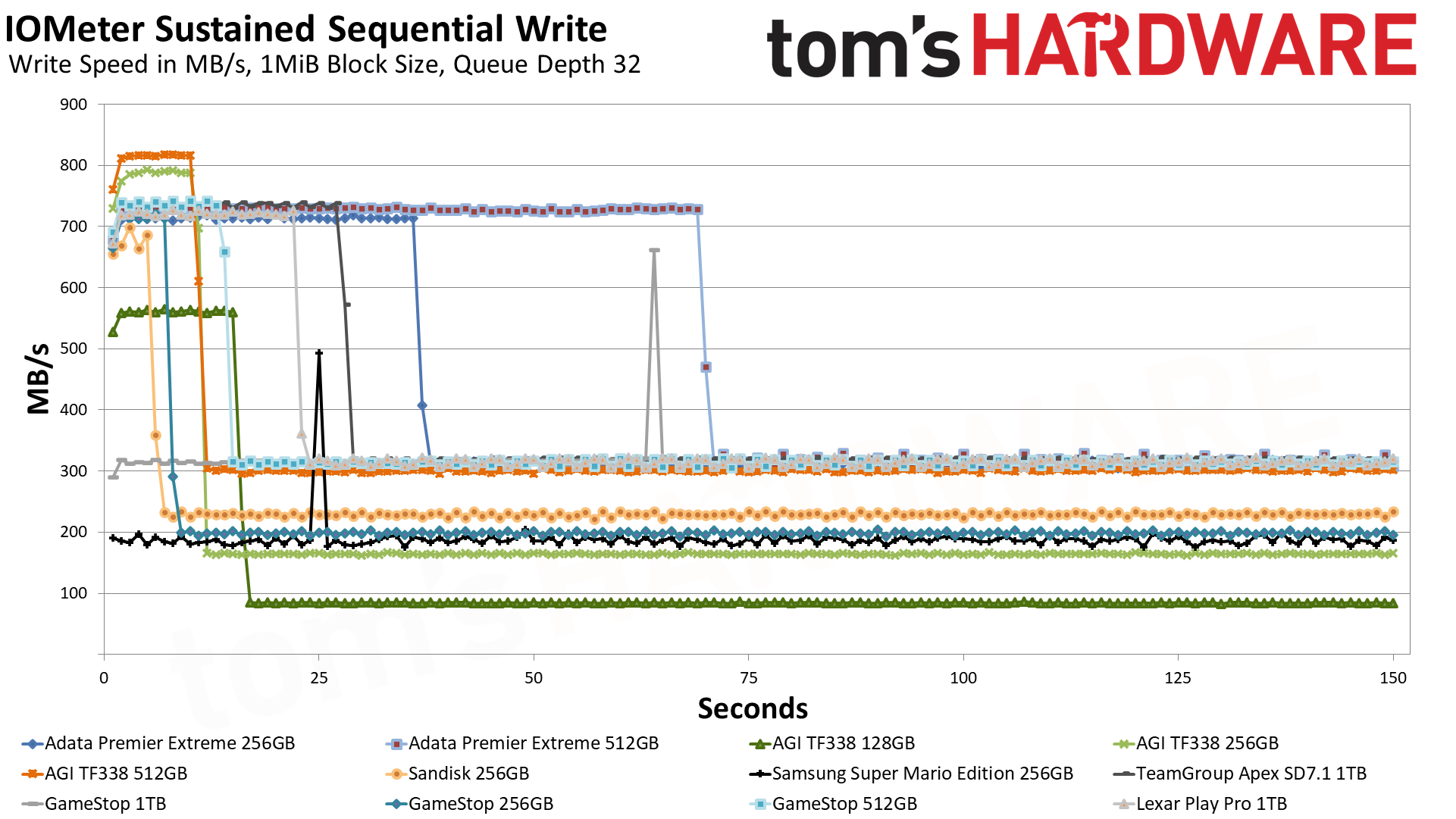
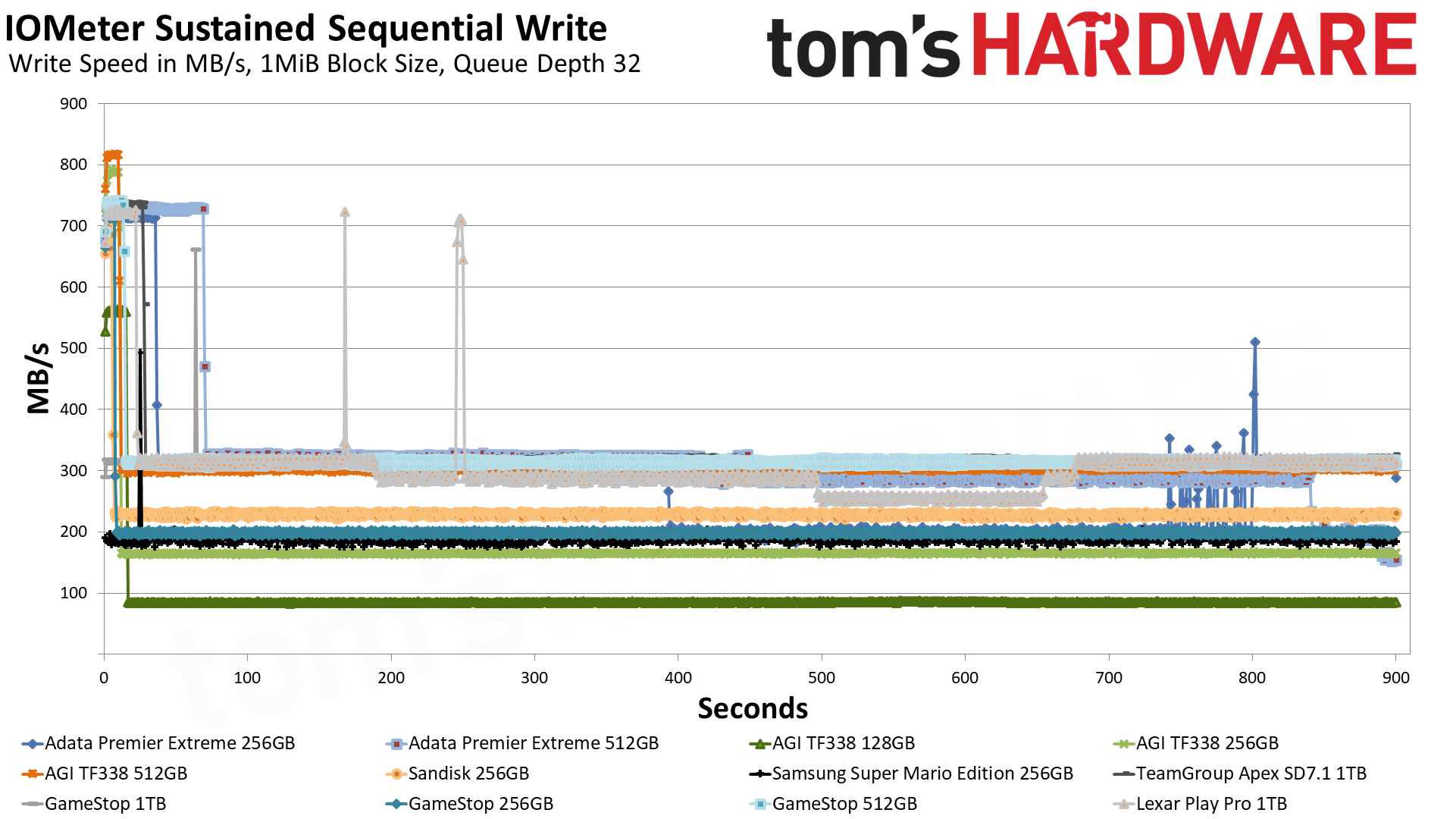
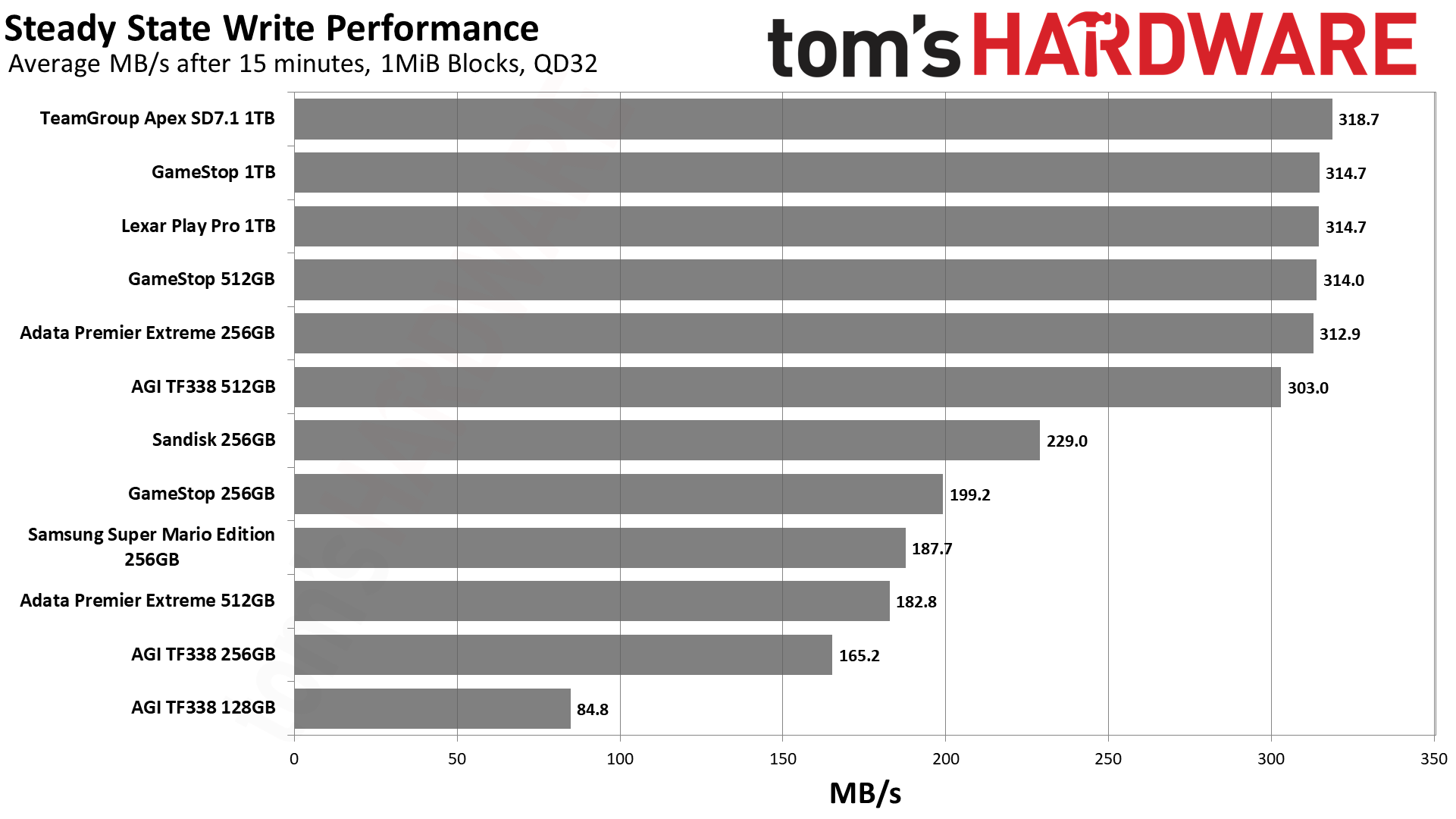
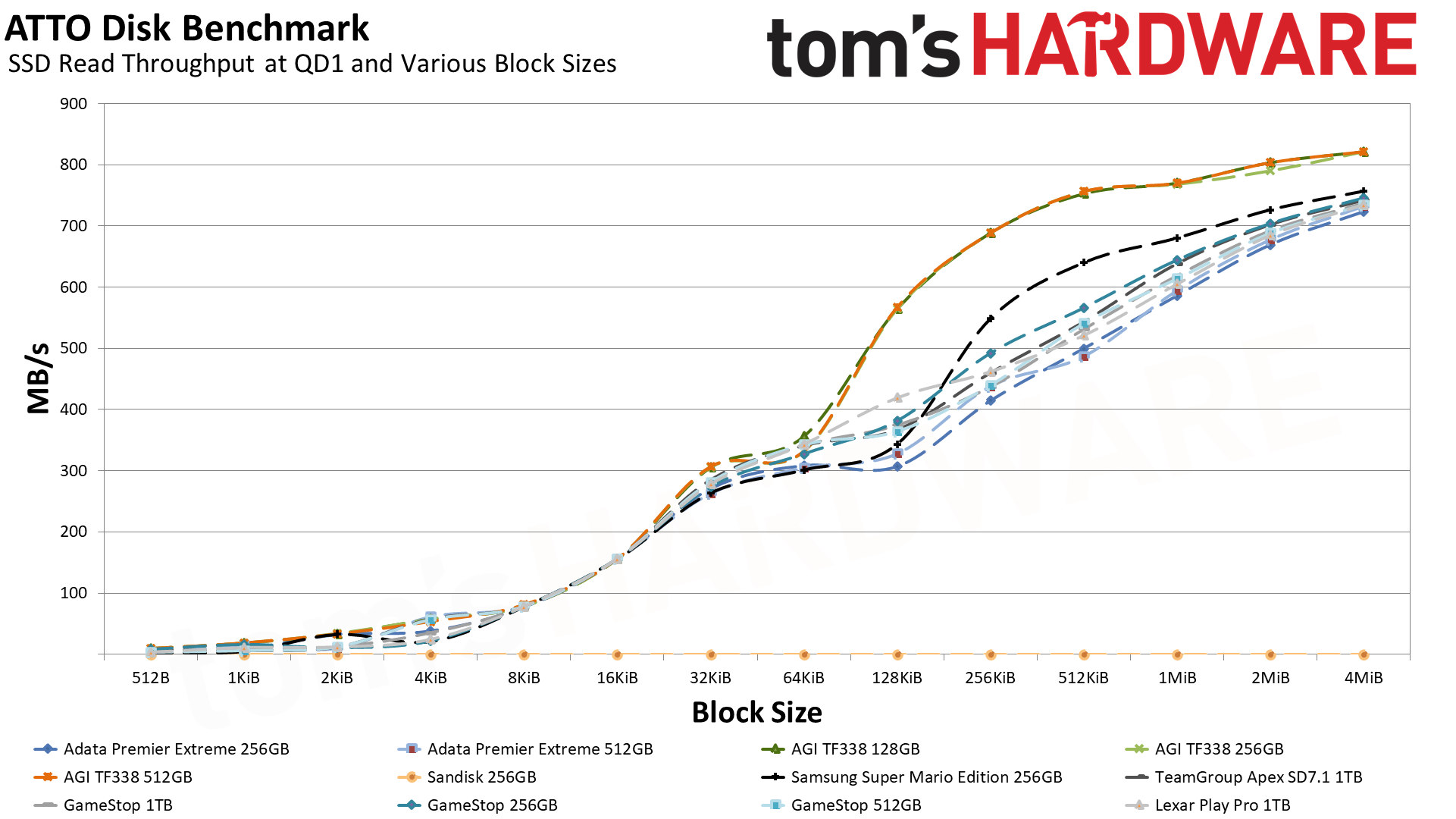
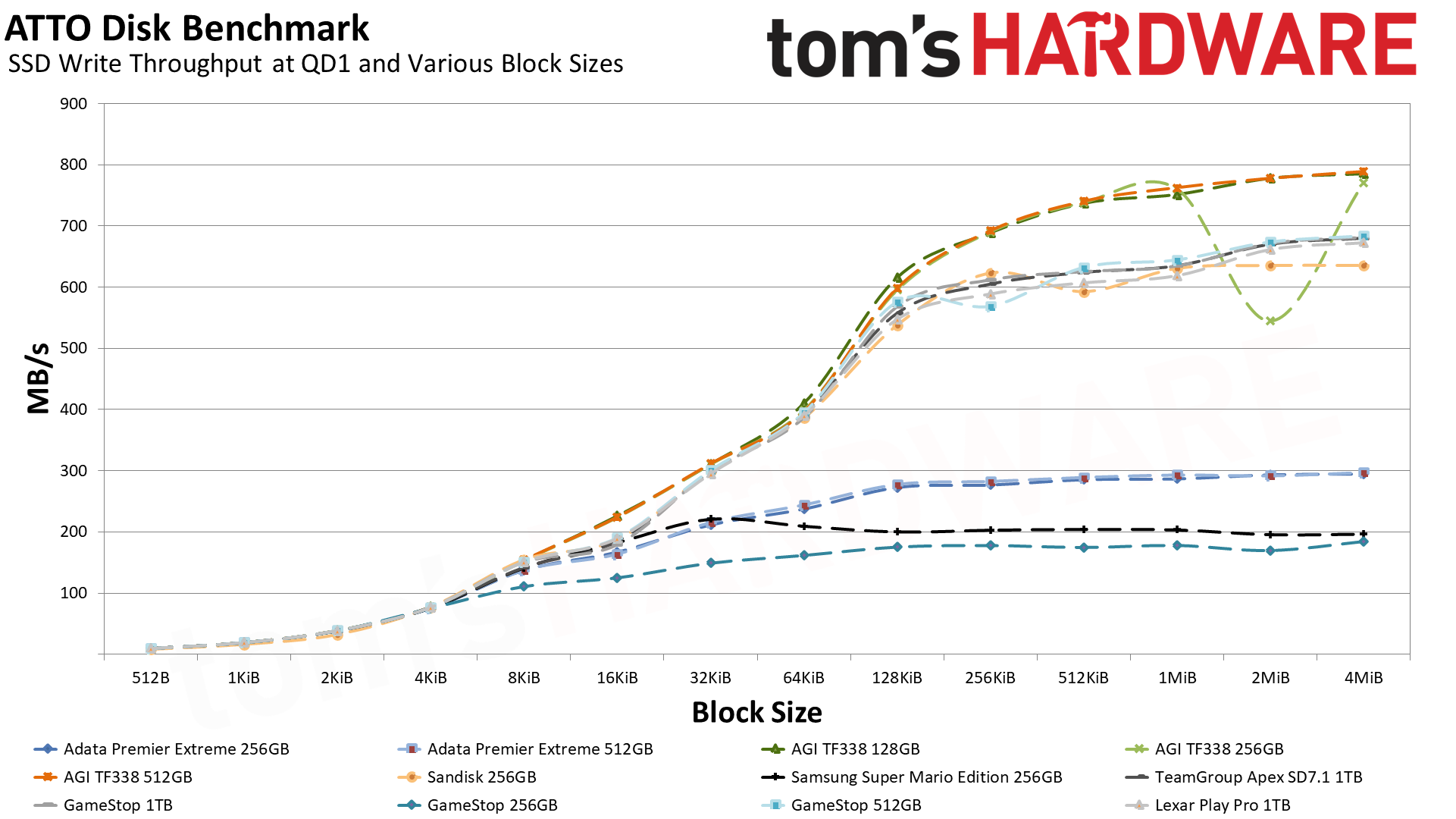
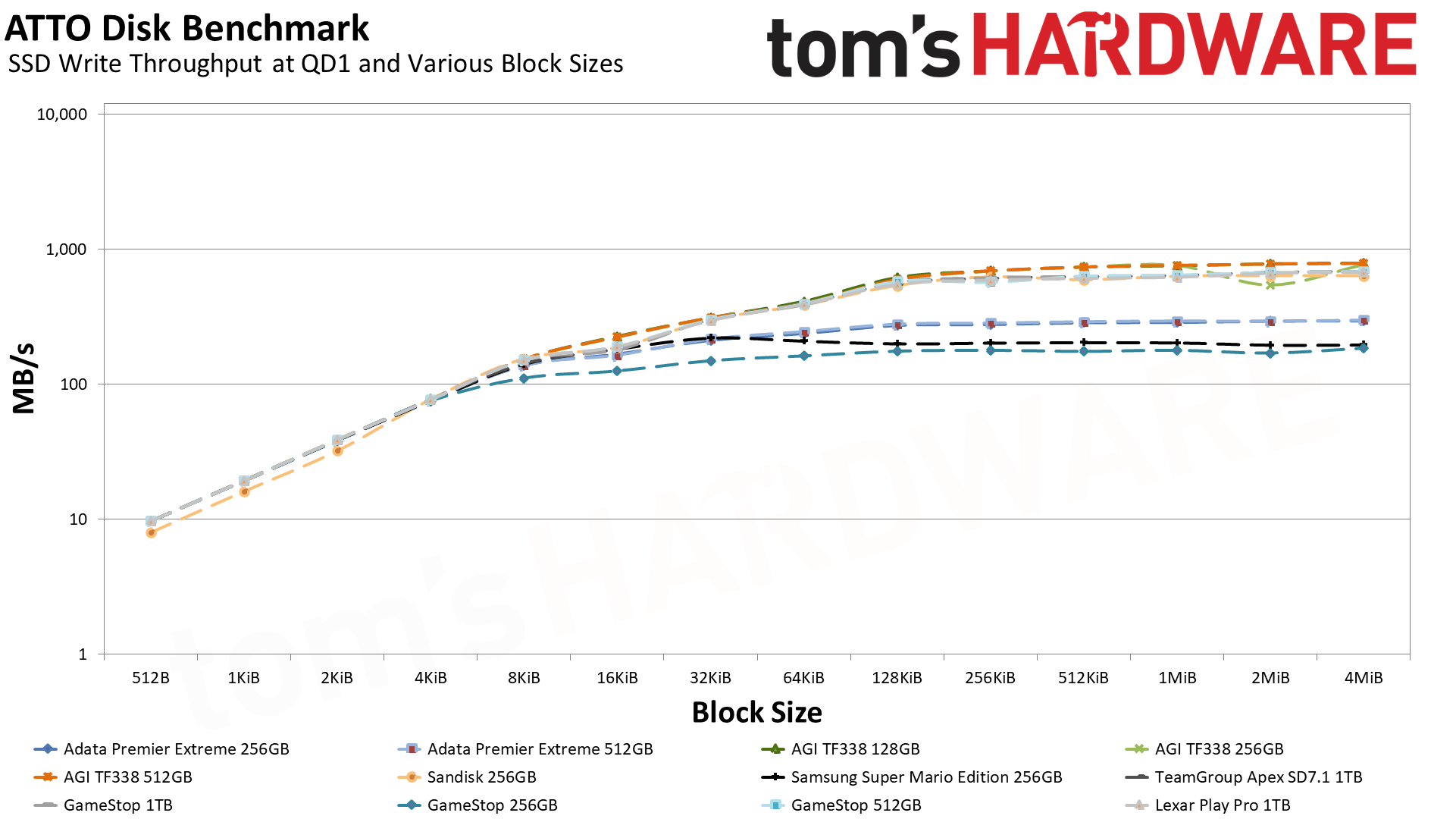
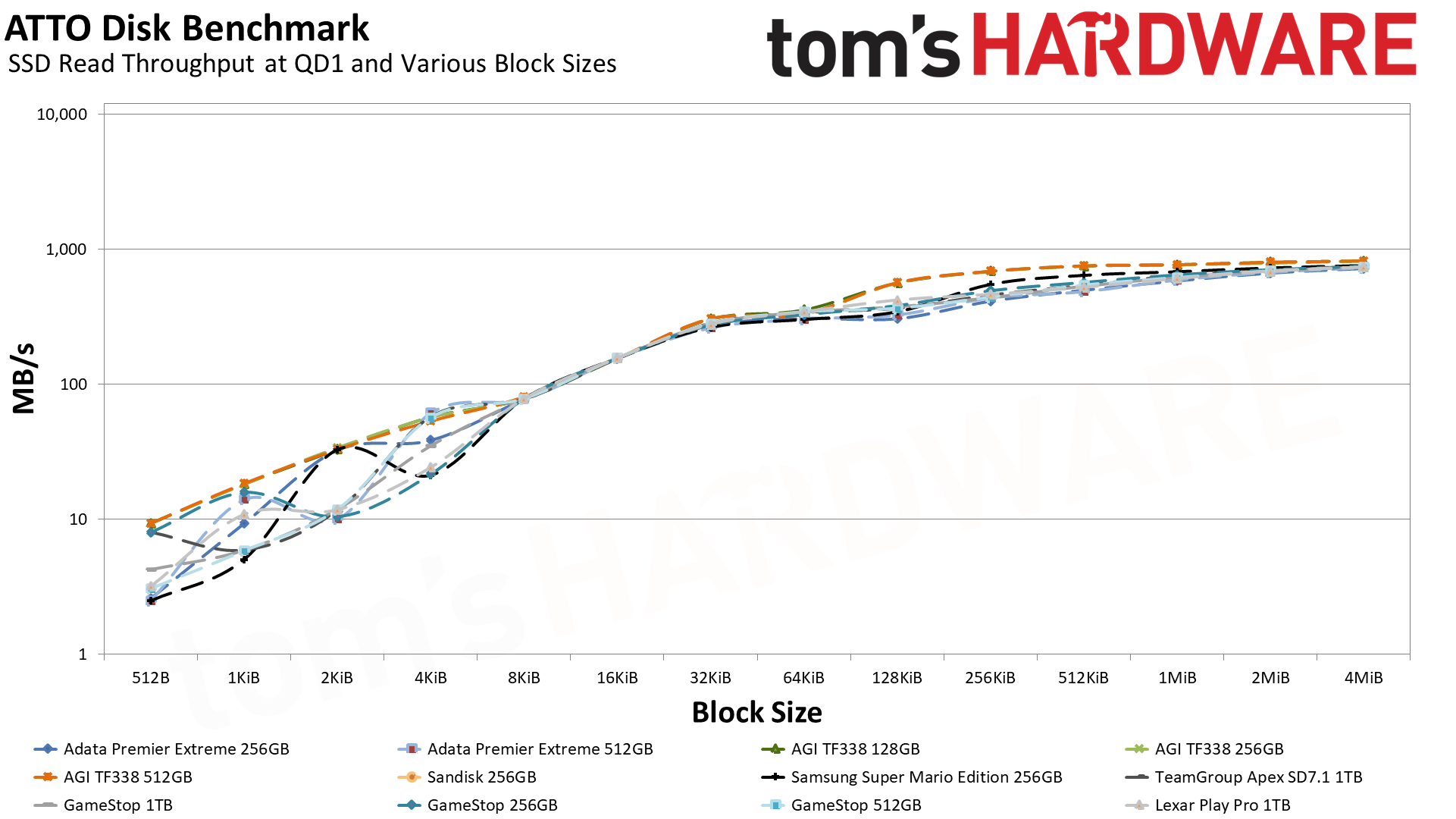
microSD Express Performance and Specifications
microSD Express Performance and Specifications
Interface | Specification | Speed (MB/s) |
|---|---|---|
Express (PCIe 4.0 x2) | SD 8.0 | 3,940 |
Express (PCIe 3.0 x2/ PCIe 4.0 x1) | SD 8.0 | 1,969 |
Express (PCIe 3.0 x1) | SD 7.1 / SD 7.0 | 985 |
UHS-III | SD 6.0 | 624 |
UHS-II | SD 4.1 / SD 4.0 | 312 |
UHS-I | SD 3.0 | 104 |
High Speed | SD 1.1 | 25 |
Default | SD 1.0 | 12.5 |
Nintendo's adoption of microSD Express cards for the Switch 2 is both a blessing and a curse. Nintendo has disabled the Switch 2 from playing games off a standard microSD card, thereby persuading gamers to pay the early adopter tax associated with new microSD Express cards if they want to play games. The new microSD Express format offers improved tangible performance compared to the regular microSD cards used in the original Switch.
The only way to expand the Switch 2's gaming storage is to buy into the microSD Express standard. The new cards have a similar resemblance to standard microSD cards. A simple way to tell them apart is to look for the 'EX' logo on the label of the microSD Express cards. If you're an experienced user, you can probably tell one card apart from the other because, although microSD Express cards have two rows of metal pins, like microSD UHS-II cards, the position and size of the pins on the second row differ.
You can still insert a standard microSD card into the Switch 2, and it'll work in a way. Usage is limited to screenshots, video playback, or file transfer, as the console doesn't allow gameplay from these media types. The funny thing is that MicroSD Express maintains backward compatibility with devices that lack support for this standard; it just defaults to UHS-I speeds in such cases. Consequently, the limitation observed in the Switch 2 is more attributable to Nintendo's design choices, potentially serving as a strategy to prevent any adverse impact on the device's reputation due to lower performance levels with standard microSD cards.
The original Switch utilizes microSD cards, specifically those that support the UHS-I interface. That's why even Nintendo advised Switch owners to select a microSD card with transfer speeds ranging from 60 to 95 MB/s (theoretical maximum for UHS-I is 104 MB/s); investing in higher standards, such as UHS-II or UHS-III, would be an unnecessary expenditure because the Switch couldn't tap into the higher transfer speeds. On the other hand, microSD Express cards offer significantly higher performance, resulting in reduced game loading and transfer times.
Speed Class | Minimum Sequential Write Speed (MB/s) |
|---|---|
E600 | 600 |
E400 | 450 |
E300 | 300 |
E150 | 150 |
The Switch 2 uses microSD Express, which is based on the SD 7.1 specifications and theoretically achieves transfer speeds of up to 985 MB/s. This represents an approximately 9.5X increase over UHS-I cards. The enhanced performance is enabled by the current SD 7.1 revision's use of the PCIe 3.0 x1 interface, finally moving away from the antiquated SD bus. The standard will continue to improve, and once it leverages a faster interface, such as PCIe 4.0 x2, projected speeds could reach up to 3,938 MB/s. However, this is a topic for another time.
Like regular microSD cards, microSD Express cards also come with their own speed classes. These ratings are designated by the "E" prefix followed by a number, which represents the minimum sustained write speed. For example, a card marked with E150 guarantees 150 MB/s of sustained write performance. None of the brands, at least the ones we tested, labeled their microSD Express cards with the appropriate speed class ratings. However, our storage benchmarks include a sustained write test, and some of the cards comply with the E150 or E300 categories.
Despite their higher transfer speeds, microSD Express cards continue to fall short compared to the Switch 2's internal UFS 3.1 storage system. UFS 3.1 technology, primarily used in smartphones and tablets, achieves maximum sequential read and write speeds of up to 2,100 MB/s and 1,200 MB/s, respectively. Therefore, when performance is at stake, the most efficient method for loading games remains loading them from internal storage. But when you're out, that's when the best microSD Express cards become relevant.
How We Test MicroSD Express Cards
We first test each card on the Switch 2, then move it to a PC test bed for further benchmarking. Although we charged the battery to 100% and had the Switch 2 connected to the wall, we used the device in handheld mode during our tests. We kept the firmware to version 20.5.0 to ensure consistency for all future evaluations. Should Nintendo release a subsequent update that improves transfer performance, we will retest each microSD Express card to incorporate the changes.
For the transfer tests, we used two games: Mario Kart World and Pokémon Legends: Z-A. We ran our benchmarks on versions 1.3.0 and 1.0.1 of the aforementioned titles, with sizes of 21.9 GB and 7.7 GB, respectively, for a total of 29.6 GB. We conducted each three times and picked the median result.
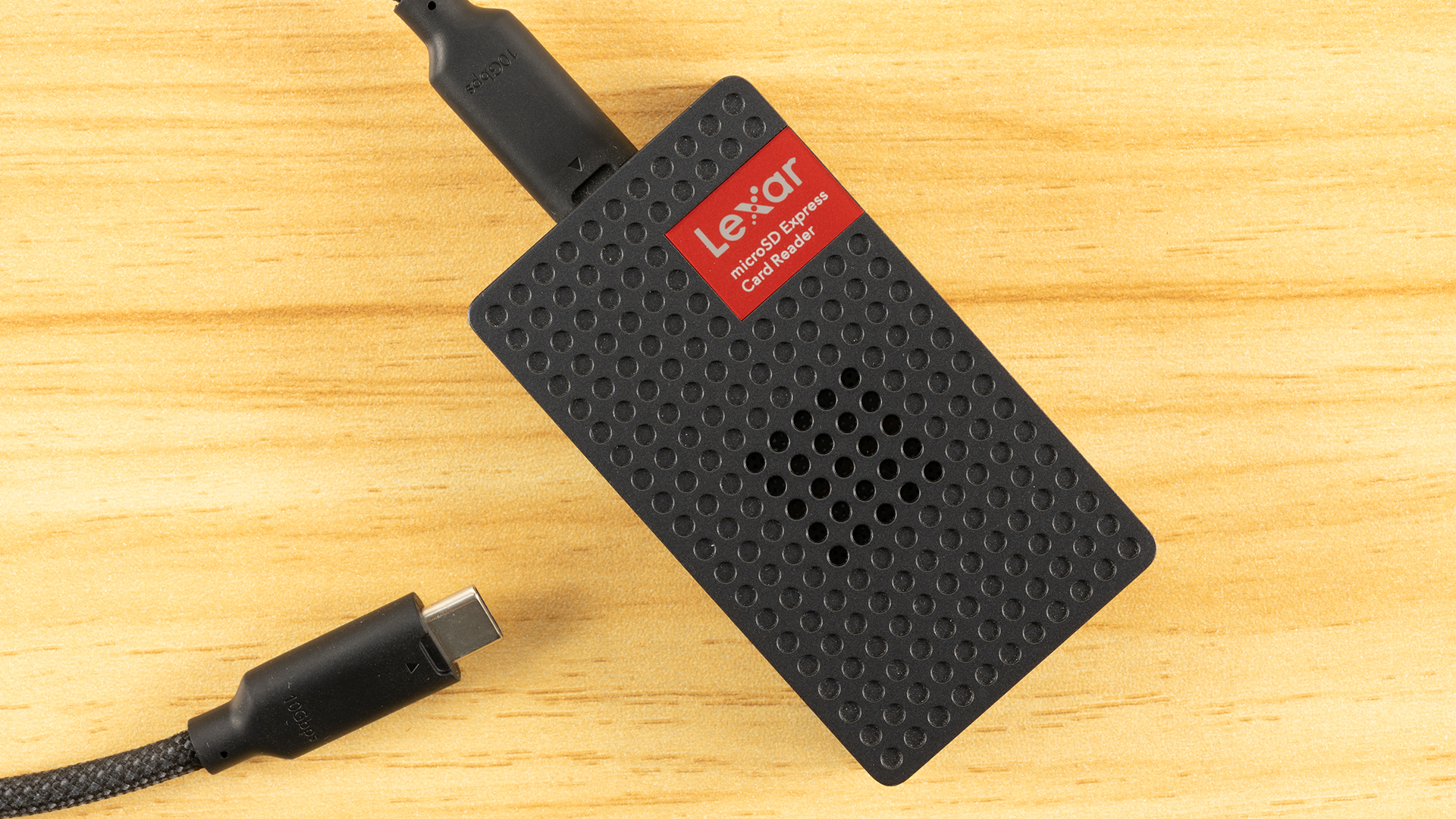
We employ a consistent PC test system for all benchmarking of our microSD Express cards. The specifications are in the table below. This system essentially serves as the test bed used in our RAM reviews. We apply our extensive SSD storage benchmarking suite to evaluate each microSD Express card. The evaluation encompasses trace tests, transfer rate tests, synthetic tests, and sustained write performance.
We have a consistent series of benchmarks, each executed multiple times. We utilize the highest result from each test. Windows 11 was held at version 24H2 to ensure consistent testing outcomes, as various security updates have influenced specific benchmarks over the years.
We utilize the Lexar microSDXC Express card reader (pictured above), available for $112 on Amazon, to interface our microSD Express cards with the system. The selection of the Lexar card reader was due to its active cooling design, incorporating a built-in fan to maintain optimal conditions for the microSD Express cards during rigorous testing. The reader connects to our system via a USB 3.2 Gen 2 Type-C port.
Component | Description |
|---|---|
Processor | |
Motherboard | |
Graphics Card | |
Storage | |
Cooling | |
Power Supply | |
Case | Streacom BC1 |
Operating System | Windows 11 Pro (24H2) |
Get Tom's Hardware's best news and in-depth reviews, straight to your inbox.

Zhiye Liu is a news editor, memory reviewer, and SSD tester at Tom’s Hardware. Although he loves everything that’s hardware, he has a soft spot for CPUs, GPUs, and RAM.
-
Xero Prime I picked up an Addlink 512 Express card for my Nintendo switch 2 for $109 on Amazon. I find it was a pretty good deal. It's authentic, works great, Reliable Wasn't that expensive? I'm going to be waiting for their 1 TB version and see what they do with that. Highly recommended if you're looking for a good SD Express card for your switch. 2Reply -
mpgtucker Do NOT buy the Gamestop brand cards. I don't know where Zhiye Liu got his information on their 1 year warranty, but I was just told that they have NO warranty, and do not accept returns once the product is opened. They want $100 for an as-is product.Reply -
zhiyeliu Reply
We reached out to GameStop, and that was what the company told us.mpgtucker said:Do NOT buy the Gamestop brand cards. I don't know where Zhiye Liu got his information on their 1 year warranty, but I was just told that they have NO warranty, and do not accept returns once the product is opened. They want $100 for an as-is product. -
mpgtucker Reply
That they have a one year, or no warranty at all? This was the response I received today:zhiyeliu said:We reached out to GameStop, and that was what the company told us.
Thank you for reaching out.
We sincerely apologize for any inconvenience. After reviewing your transaction details using the receipt you provided, we confirmed that your SD card was purchased in June and that no extended warranty was included with the purchase.
As outlined in our return policy:
Refunds: Eligible within 15 days of purchase for brand-new, unopened items
Exchanges: Opened items are eligible for exchange only if defective, within the same 15-day window
Extended Warranty: If purchased, allows for replacement beyond the standard policy — however, this was not included in your transaction
The store that attempted to sell me another card today told me that there is no extended warranty available. -
zhiyeliu Reply
That the card comes with a one-year manufacturer’s warranty. That was the information that GameStop provided to us when we contacted the company to inquire about the warranty period.mpgtucker said:That they have a one year, or no warranty at all? This was the response I received today:
The store that attempted to sell me another card today told me that there is no extended warranty available.